The Royal Navy started the Great War with the largest contingent of cruisers of any nation on earth, nearly 200. However between new constructions and the need of manpower, many of the late 1880s and early 1890s generation started to be placed in reserve. The typology changed considerably and Britain led the pack in terms of denominations: Early 1880s cruisers were later assimilated to “unprotected cruisers” or “3rd class”, distinguished from protected cruisers of 2nd or 1st class, anr armoured cruisers from the mid-1890s. Britain did not enlisted “torpedo cruisers” as they were assimilated to gunboats (more fitting).
And from 1906 onwards, with HMS Dreadnought, a serious rethinking of the role of the cruiser led to a new class, the “scout cruiser”, which was at first lightly armed, only to fight off German high sea torpedo boats in the north sea and screen the fleet. This led to all prewar and wartime designs under alphabetic letters, A to E. Post-Washington treaty, all the C, D and E class were still in service and were seen still as valuable escort ships in WW2.
The Washington Treaty added two more classifications: The “minelayer-killers” of the Frobisher class (“Elisabethans”) started in 1916 but not completed in time were later assimilated to the first “heavy cruisers”, due to their heavy artillery, and the treaty category was created in part based on there standard, later precised at London in 1930. Also the former C to E class ships were now part of the new “light cruiser” category, based on artillery and tonnage at first.
General Introduction

The whole package: All cruisers in active service in 1914. Note: To free crews for new cruisers, many were discarded or placed in reserve, converted to depot ships, tenders, training vessels or floating barracks during the war. The poster also includes classes that were completed postwar, such as the heavy cruisers of the Frobisher class and the “E” class cruisers. Four of the latter were completed in 1925-26… Also most cruisers seen here, apart the “C” and “D” class were discarded and scrapped in the early 1920s due to Washington naval limits. The Armoured cruisers, protected and/or 2nd/3nd class cruisers in particular were scrapped. Not shown here were the many auxiliary cruisers (converted liners) also commissioned by the RN in wartime.
The ancestors: Birth of British Cruisers
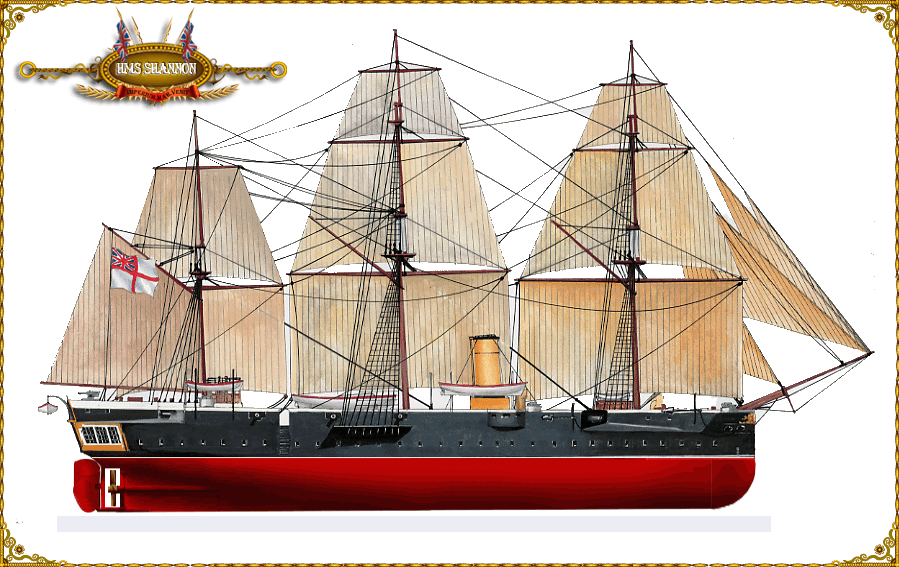
HMS Shannon, that some historians flag as the “first armoured cruiser”.
Like in most countries, Britain had Frigates aside its ships of the lines, that were upgraded to steam power at the turn of the XIX th century. In 1860, the appearance of the Ironclad did not change much the role and appearance of the Frigates, albeit there were questions of up-armouring the largest. In the end, in 1873, HMS Shannon became the first “armoured cruiser”; That’s the term used at the time, and so all fleets took notice. She was in effect not a successful ship, more akin to a coastal central battery ironclad as she was not well protected, and lacked speed and range. Nevertheless, the terms of “cruiser” started to make its way in naval circles.
The original of the cruisers are foggy, but the term only started to be applied on steam-only ships. The mixed ones were still “frigates”. This transition and coexistence started on the late 1870s.
The fleet had a range of iron frigates, armoured or not, wooden screw, composite and iron corvettes which also played this role, as well as sloops, later assimilated to gunboats.
The development of cruisers was slow however.
Compared with the development of the ironclad, progress in the design of cruising ships during the 1860s and 70s was comparatively slow and conservative. In general the cruisers constructed during this period, mainly corvettes and sloops, represented the continued development of pre-ironclad types with major improvements restricted to the adoption of the latest types of machinery and ordnance. To Britain, with her world-wide empire and trade, these vessels were essential for service on foreign stations where great distances and limited coaling facilities made sail power essential and the lack of docking facilities made wooden hulls a more economic proposition than iron ones. However they were more representative of peacetime ships than wartime ships, providing a relatively inexpensive means of carrying out police work, showing the flag and dealing with minor conflicts in distant waters.
In a major war they would have been of little use for they lacked one essential of a cruising ship ~ speed. Most could make little more than 13kts, which could be exceeded by more and more ironclads as the development of capital ships progressed, and if employed as fleet scouts or even on trade route patrols they stood a very good chance of being sun down by a more powerful enemy. There were a few exceptions, all constructed of iron, such as the frigate Inconstant and the corvettes Active and Volage which were capable of 15-16kts, but these were too few to provide the battle fleet with a balanced cruiser force. Apart from these early iron frigates and corvettes the only major cruising ships constructed for the Royal Navy until the 1880s were the armoured cruisers Shannon, Nelson and Northampton of 1873-74 but these vessels were essentially second class ironclads designed to serve on distant stations and again were too slow to be correctly classed as cruising ships.
Two more ships of this type, the Imperieuse and Warspite, were Jaid down in 1881, and although a considerable improvement on the earlier trio they were of equally limited value. They did however serve to finalize the end of sail propulsion as a serious proposition in British warships. The captain of Imperieuse, in his report on her trials, carried out in 1886, stressed the fact that her brig rig served tittle purpose and that she would be a far better fighting ship without it. Shortly aftetwards it was removed and henceforward British cruisers joined they battleship counterparts in being constructed without sailing rig.
The genesis of British Cruisers
It was during the Barnaby era of 1870-86 that the true cruising ship of the British fleet underwent its initial development, The pattern was provided by the dispatch vessels Iris and Mercury built during 1875-79, These were the first British warships to be constructed of steed and, with comparatively fine lines and powerful machinery, were designed for a speed of 17kts. They relied for protection on sub-division and coal bunkers and were of limited endurance but their basic design, with the addition of a protective deck and an increase in coal capacity, was utilized to provide Britain’s first modern cruisers, the Leander (1880) and Mersey (1883) classes, which were designed primarily for trade protection.
The eight ships of these two classes were however hardly Sufficient to fulfil Britain’s needs and the Northbrook Programme of 1884 laid particular emphasis on the provision of cruising ships. The tesult was the seven armoured, or belted, cruisers of the Orlando class and the light torpedo cruisers of the Archer class, none of which was tntirely successful. Unlike the earlier armoured cruisers, the Orlandos Were (rue cruisers and not second class battleships, and were given a Speed and endurance to match their designation, but their system of Protection, a narrow waterline belt, was of such insignificant value as to present no more than so much dead weight. As a result the Admiralty abandoned side protection in cruisers for 13 years (although it continued to be employed in foreign ships) and concentrated on the Construction of protected cruisers. The Archer class were small fleet Cruisers, based on the earlier Scour and Fearless and designed to carry out torpedo attacks and defend the fleet against torpedo boats, but they were too slow and insufficiently seaworthy to carry out their functions effectively and the type was not repeated.
The William White Era
The final stabilization of cruiser types and designs was provided by William White who became chief constructor in 1886. His early designs, the Medea class of the 1886-87 Programme and the Blake, Barracouta and Barham classes of the 1887-88 Programme, introduced a number of important features. Two of the Medeas were fitted with vertical engines which were more efficient than horizontal engines and occupied a shorter length of the ship as they could be mounted side by side instead of fore and aft. The main objection to this arrangement, that the engine cylinders were above water and vulnerable to gunfire, was overcome by fitting a raised armoured glacis in the protective deck above the engines. The 1887-88 Programme ships were the first to carry QF guns, which rendered the earlier cruisers virtually obsolete, Barnaby’s ships were designed to carry only such protection as was necessary to preserve the ships’ stability, the majority of the above water hull, including the guns and their crews, being left open to attack. With the slow firing BLR gun this was an acceptable risk, but not with the QF gun.
In Blake and Blenheim the problem was partially solved by providing a wider distribution of the armament and fitting armoured casemates and shields for the guns. The casemate, which was to become a major feature of White’s first class cruisers and battleships, proved a mixed blessing. In general the majority of guns so mounted were fitted on the main deck where their close proximity to the waterline made them almost useless in anything but calm weather, but the arrangement continued until White left the Admiralty in 1903. In the smaller cruisers there was insufficient weight available to provide casemates, and gun protection was effected solely by shields and the widest possible distribution. It is worth noting here that White’s ships were often crrpawed for being undergunned compared with their foreign counterparts but 1a mont cases the Brush vessels were designed for more exact ng requirements af seaworthiness and endurance which could not haveboon« bsacds cessfully with a heavier gun battery. However, this 6 a general sat). and wt ss clear from the fact that several of Whine sore ser were refitted with heavier of additional weapons that there was taom fo satne improvement, although not on the scale sugpertod ta some cet 4
Whice cxty ct wee deugns coincided with a considerable enthuse for the proneson of forced draught in which the power genet ated t togier was greatly increased by raising the air pressure in the slokeh. to force ae through the furnaces. The system had been in use fat wmetal years but in the late 1880s was taken to extremes, much to the cost af the Ray al Navy, Unlising this feature, White designed the Mode as for 20ke, the Blakes for 2kisand the Barham class for 19, 5kt5, but in na case did the completed ships achieve these speeds, ‘The heat Benerated by forcing was so great that the water in contuct with the bailer tubes tended to be lifted away completely by the generation of steam leaving the tubes to become overheated, whence they quickly began to break down and Icak, causing extensive and costly damage.
The worst cases were those of Barham and Bellona, whove small boilers were designed to accept a forced power 60% above that of their nominal power, and on trials their boiler tubes started to break down long before reaching this extreme limit. Subsequently the difference between natural and forced draught power was considerably reduced and was abandoned compictely in the late 1890s when machinery design had improved sufficiently to provide the necessary speed without forcing. [tis interesting here to note that throughout White’s period of office the speed of all except the first class cruisers remained at around 20kis, which gave only a limited margin of speed over the battle fleet. It seems likely however that this was not so much a matter of policy as technical feasibility, since higher speeds were only possible at this time with greatly increased size.
List (No longer active or long discarded, BU)
Armoured cruisers:
-Shannon (1875): sold 1899
-Nelson class (1876): sold 1905-1910
-Imperieuse class (1883): sold 1905, 1913
-Orlando class (1886): Sold 1905-1907
2nd class Cruisers
-Iris class “dispatch vessels” (1877), sold 1905
-Leander class (1882), sold 1905-1947
-Mersey class (1885), sold 1905-1947
-Medea class (1888), sold 1905-1920
-Apollo class (1890): Some took part in WWI, see below.
3rd class cruisers
-Surprise class despatch vessels (1885)
-Scout class torpedo cruisers (1885)
-Archer class torpedo cruisers (1885)
-Barracouta class torpedo cruisers (1889)
-Barham class (1889)
-Pearl class (1889)
-Pelorus class (1896)*
*some still in service WWI, see below.
Prewar Cruisers
British Protected/Armoured Cruisers
 Blake class (1889)
Blake class (1889)
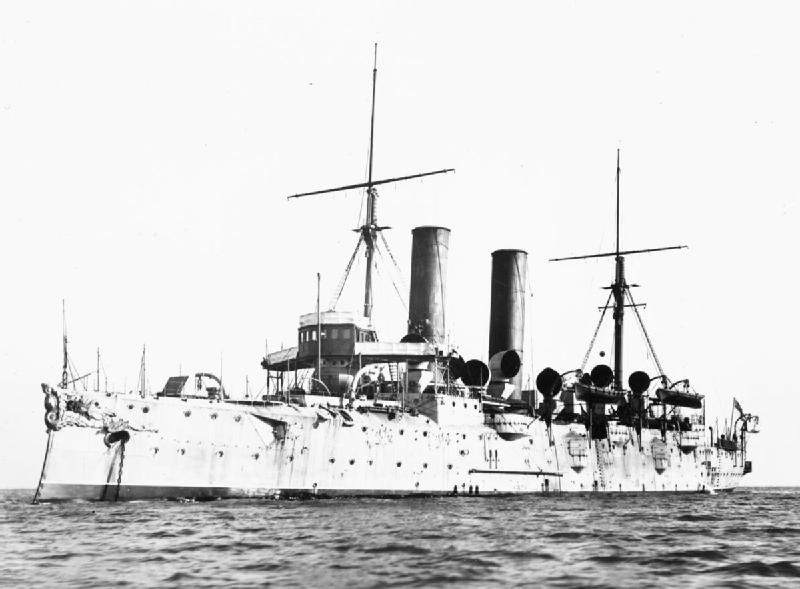
The Blake-class were armored cruisers built for the Royal Navy with the lead ship being HMS Blake, followed by HMS Blenheim and HMS Blanche all named after prominent British naval officers. Their main armament consisted of two 9.2-inch (234 mm) Mk VIII guns mounted in single turrets, one forward and one aft. Additionally, they were equipped with several secondary guns, including 6-inch (152 mm) and 4.7-inch (120 mm) guns.
They were armored to varying degrees, protection covering vital areas such as gun turrets, conning tower, machinery spaces. The armored belt was designed to provide protection against enemy gunfire.
They were powered by a combination of triple-expansion steam engines and boilers for a top speed of around 20 knots, relatively fast for their time.
Service History: HMS Blake, lead ship of the class, was commissioned in 1892 and served as the flagship of the Mediterranean Fleet. The other two ships, HMS Blenheim and HMS Blanche, were commissioned in 1894 and 1893, respectively. They saw service in various capacities.
They were obsolete in 1914 and served as depot ships. HMS Blenheim however supported the Mediterranean Expeditionary Force and Gallipoli campaign, then and repatriating three dignitaries after their deaths abroad: Prince Henry of Battenberg former PMs Sir John Thompson and Sir Charles Tupper. They underwent modifications and refits during their service lives until 1926.
http://www.navistory.com/FR/1ere-guerre-mondiale/royal_navy.php#crois
 Edgar class (1890)
Edgar class (1890)
Edgar, Endymion, Grafton, Hawke, Theseus, Royal Arthur, Gibraltar, St Georges
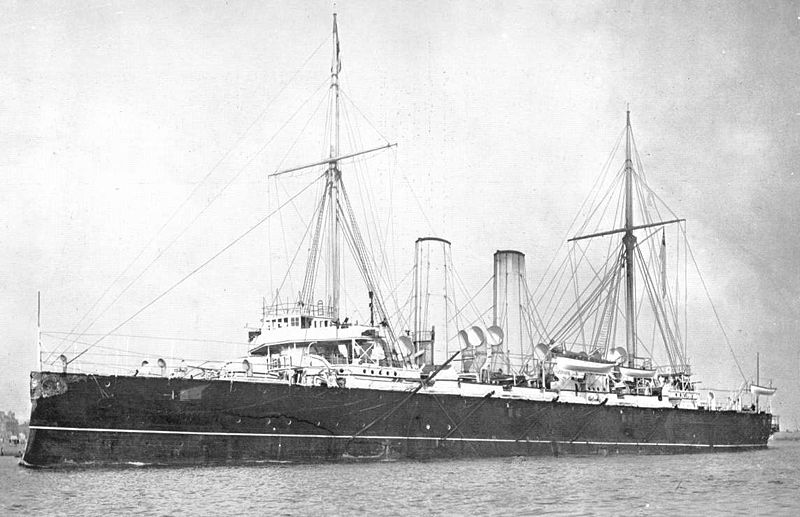
From the 1889 program, these 9 cruisers were reduced versions of the Blakes of 1890, with the same armor and the same armament. Machinery was reduced, and the tonnage lowered by 1,800 tonnes. However, new machines were enough to reach 20 knots and have a range of 10,000 nautical miles. During sea trials they proved their great endurance. These ships could sustain, for example, 18 knots for 48 hours. They also had better seaworthiness. Four units, HMS Royal Arthur like Gibraltar and St Georges was built using large quantities of wood and copper for overseas service. Crescent and Royal Arthur were also the only ones in the class to have a raised forecastle, improving habitability and handling in heavy weather. They were 350 tons heavier, and also carried two 6-in forward guns at the front instead of a single heavy 9.2-in (234 mm) like their sister ships.
These ships began their careers in distant stations, Hong Kong, East Indies, Mediterranean, South Africa, Australia and the Pacific. Their career was more or less active during the Great War:
HMS Crescent was part of of the 10th Cruiser Squadron in 1914, conducting patrols in the North Sea. In February 1915 he was assigned to the defense of Hoy. In November she was decommissioned and converted into a supply ship anchored at Hoy. He then returned to Rosyth to be discharged in 1918.
HMS Edgar operated alongside other units of her class in the 10th Wing operating in the North of Scotland. In November-December 1914, their heavy parts were removed to equip them with new monitors. It was then kept at anchor then rearmed with 152 pieces (12 in total) and equipped with huge side ballast tanks in order to carry out bombing missions on the Flemish coast. In May 1915 he was transferred to the Dardanelles and operated there until 1918, when he was retired.
HMS Endymion was assigned to the 10th Squadron also in 1914. She was subsequently decommissioned, then rearmed and fitted with ballast tanks like the Edgar for service in Flanders, but was transferred immediately to the Dardanelles. She then served in the Aegean Sea and was decommissioned in 1920.
HMS Gibraltar served in the 10th Cruiser Squadron. In March 1915 she was decommissioned and anchored at Swarbacks Minns in the Shetland Islands to serve as a supply ship to the 10th Flotilla from June 1915. She was then sent to Portland to be assigned to the anti-submarine school. underwater. She then became a destroyer supply ship from 1919 to 1922.
HMS Grafton was also detached to the 10th Flotilla in 1914. She was then stripped of heavy guns, then rearmed and equipped with ballast, in view to bombard Flanders. Ultimately, he was sent like the others in mid-1915 to the Dardanelles to support the landings. On June 11, 1917 she was hit by a U-boat torpedo, but survived and was towed for repairs. She then served in the Aegean Sea until the armistice, then in the Black Sea to support the “whites”, as a supply ship. She was decommissioned and demolished at the end of 1919.
HMS Hawke served with the 10th Northern Squadron in 1914. She narrowly escaped sinking following a collision with much larger liner SS Olympic. She lost her bow however and was repaired but without her ram, removed during repairs, so straight bow. She served from 1908 to 1913 at Portsmouth, briefly a cadet training ship. She was torpedoed on mission on October 15, 1914 by U9, and sank with 524 crewmen.
HMS Royal Arthur was seconded to the 10th Squadron in 1914. In February 1915 she was reduced to a submarine supply ship, a role she held until 1919 at Scapa Flow. He witnessed the great scuttling of the Hochseeflotte. HMS St Georges was placed in reserve, after having been used for the training of cadets, from 1906. She served as a supply ship, and was converted for this purpose at Chatham from 1909. She served with the 9th destroyer flotilla in 1914. In November she was rearmed and served as a patrol boat based on the Humber. In 1917 she was converted into a supply ship for subs, sent to the Mediterranean. She served in the Aegean Sea in 1918-19 with the 2nd Flotilla and was withdrawn from service in 1920.
HMS Theseus served as a supply ship to HMS Cambridge from 1905 at Devonport. In 1914, she was detached to the 10th squadron operating in the North of Scotland, then was transformed at the beginning of 1915, rearmed like the other cruisers of the class and equipped with ballast. She was sent to the Dardanelles and served in the White Sea in 1916, before returning to the Aegean Sea to serve as a supply ship, and finally in the Black Sea, in support of “White” Russian troops. She was withdrawn from service in 1920.
Displacement & Dimensions: 6870t, 7700 T PC, 113.11 x 18.29 x 7.24 m
Propulsion: 2 propellers, 2 2-cylinder machines. TE, 4 cylindrical boilers, 12,000 hp. and 20 knots max.
Armor: Ammunition well 160, Shields 76, Blockhouse 305, bridges 120-76, casemates 152 mm.
Armament: 2 x 234, 10 x 152, 12 x 57, 5 x 47, 4 x 457 mm TTs (sub).
Crew: 544
 Powerful class (1895)
Powerful class (1895)
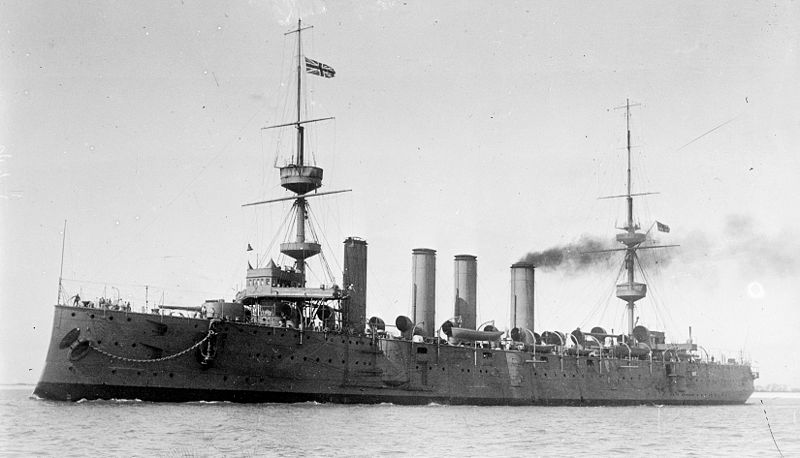
These two impressive ships, apart from the technical aspects, perfectly embodied British naval supremacy, both in quantity and quality. True military liners, they were in fact viewed retrospectively as “great white elephants”. Their construction, however, came from the Admiralty’s need to be able, if necessary (in a “Crimean War” type scenario), to build the two large Russian cruisers Rurik and Rossia, then undoubtedly among the largest warships afloat. In fact, upon their completion in 1897 and 1898 (with construction lasting 4-5 years), they took up the torch of the largest warships in the world. Revealingly named “Powerful” and “Terrible”, they displaced twice as much as the previous cruisers (Edgar class), and correspondingly cost twice as much. Their crew of almost 900 men, like their supplies, also made them expensive to maintain.
On a technical level, they were the first ships of this size to use Belleville water tube boilers, which caused development problems and repeated breakdowns. Despite this, their machines gave them a satisfactory speed, maintained over the duration of their service. During tests, their four funnels (a first in the Royal Navy) proved too short and they had to be raised by five meters. Their three-deck configuration gave them much greater habitability although their armament distribution remained classic: They only gained two 6-in guns, and their 9.2 in guns were in turrets rather than protected by shields, and for the first time their 6-inchers were partly protected by two-storey barbettes.
All their artillery was thus perfectly protected. For the rest, their size did not justify armament similar to previous buildings, and in 1904, four more 6-in guns were added to their upper deck. Their speed, on the other hand, was 3 knots higher and thanks to their 3000 tonnes of coal carried, their autonomy was much greater. Not very maneuverable because they were very long, they were quite seaworthy and good walkers.
At the start of their career, these two ships were based in China, then returned to South Africa with marine infantry campaigns on board. In 1899, they made headlines by landing their troops at the Cape to support Ladysmith during the Boer War. In 1902-1904 they underwent a small overhaul, then were placed in reserve, because they were considered too expensive in service. It was not until 1915 that HMS Terrible was reactivated, and used as a troop transport, sailing to the Mediterranean, then returned to reserve at Portsmouth, serving as a utility ship at anchor until 1920. Renamed Fisgard III, she then served as a training ship until 1932. HMS Powerful for her part only came out of reserve in 1915 to serve as a training ship at Devonport. Her vast dimensions, like her twin, predestined to this role, continued service from 1919 under the name Impregnable II, then until 1929.
Technical specifications
Displacement & Dimensions 14,200 t, PC, 164 x 21.6 x 7.3 m
Propulsion 2 propellers, 4 mach. cyl. TE, 48 Belleville boilers, 25,000 hp. and 22 n. max.
Armor Belt 100, Battery 152, Barbettes 152, turrets 152, blockhouse 152, bridge 152 mm.
Armament 2 x 234 (2×1), 12 x 152, 16 x 76, 12 x 47, 4 x 457 mm (bd Sub).
Crew 894
 Diadem class (1897)
Diadem class (1897)
Amphitrite, Andromeda, Argonaut, Ariadne, Diadem, Europa, Spartiate
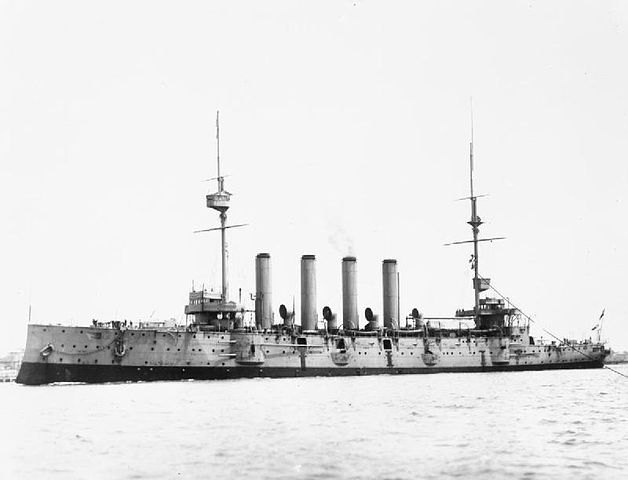
HMS Ariadne
The 8 Diadem were an attempt to stand out from the large Powerful class considered too expensive. They had reduced size, armor, saving a total of 3,000 tons with and 100,000 pounds in cost per ship, which was almost the cost of a light cruiser. Built in two groups, they had a powerful machinery still, to gain half a knot. Good walkers, they easily reached their desired speeds, although HMS Niobe suffered from engine failures and other in this class developed boiler problems in service. They were criticized for their lack of heavy guns and unsufficient protection (shields rather than turrets).
At the start of their career, three operated in China and one in the Mediterranean, the others remained in territorial waters.
HMS Amphitrite was stationed in Cape Verde at the start of the war, as part of the 9th Cruiser Squadron. From June 1915, he went to Portsmouth to be converted into a minelayer. In August 1917 it had been rearmed with only four 152 mm guns (bow and stern) and one 102 mm AA. It could carry 354 mines and since its release in August 1917, laid some 5,053 mines, replacing Ariadne on Dover Dam. Worse, it was the great dam of the North in the company of the US Navy. She was involved in a collision in September 1918 with the destroyer Nessus and withdrawn from service in June 1919.
HMS Andromeda was anchored at Devonport and served as a training ship, a role she held until 1919. Then, renamed Impregnable II, she held this role until 1929. In 1931, she became a torpedo training ship. Renamed Defiance, she then survived as a depot and training ship until 1956.
HMS Argonaut was stationed until 1915 at Cape Finistère with the 9th Cruiser Squadron. He captured the German armed freighter Graecia. She was placed in reserve at Portsmouth in October 1915, then converted to a hospital ship until 1917, then a barracks ship until 1920.
HMS Ariadne was a stokers’ training ship in 1914 at Portsmouth. She was transferred to Devonport in 1915 and converted to a minelayer like the Amphitrite in 1917. She could lay 400 mines, and from March was sent to lay mines at Dover Dam and Heligoland Bay, but on July 26, she was torpedoed by UC 65 off Beachy Head, with 38 casualties.
HMS Diadem was stationed as a stokers’ training ship in 1914 at Portsmouth. In October 1915 her activities were ended and only resumed briefly in 1918. She was sold in 1921.
HMS Europa operated at Cape Finistère in 1914 with the 9th Cruiser Squadron, of which it was the flagship. He was then sent to the Mediterranean, operating in Mudros and Malta after the war. She was sold in 1920.
HMS Niobe operated with the RCAN and suffered a grounding before the war. In 1914 she was based in Bermuda. In October 1915 she was anchored in Halifax, decommissioned, as an ammunition depot ship. A nearby warehouse exploded and seriously damaged it. She was not repaired but remained as a pontoon until 1922.
HMS Spartiate was a stokers’ training ship in 1914, a role she held until 1932, under the name (from 1915) HMS Fisgard.
Technical Specifications
Displacement & Dimensions 9,900 t, 11,000 t FL., 140.97 x 21.03 x 7.77 m
Propulsion: 2 shafts, 2x 4-cyl VTE, 30 boilers, 16,500 hp. and 20.5 kts
Armor: Belt 152, Casemates 102, Shields 100, turrets 76, CT 305, bridges 100 mm.
Armament: 16 x 152mm, 14 x 76mm, 3 x 47mm, 3 x 457mm TTs (SM).
Crew 677
 Cressy class (1899)
Cressy class (1899)
HMS Cressy, Hogue, Aboukir, Sutlej, Bacchante, Euryalus (1899)
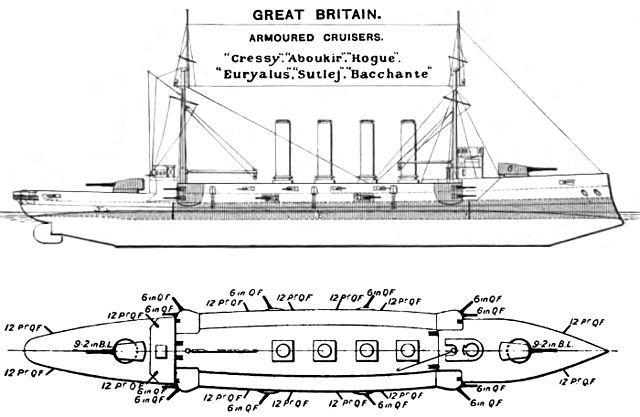
Six large cruiser ordered in 1898, using the design of the previous Diadems, but with significant protection, greater power to safeguard speed and armament as the Powerful class. Progress came from the adoption of lighter yet stronger, more flexible Krupp side armor plates, which spared tonnage. The ammunition wells and bunkers were also armored and the internal casing reinforced. The heavy turrets had the advantage of being hydraulic and adjustable at any angle (including raising) while allowing reloading.
These ships had a silhouette and a size close to that of the Diadem, yet the hull was fuller but they still ended 1000 tonnes heavier, for the benefit of stability, while having a better profiled stern, for the benefit of maneuverability. They were also good walkers, exceeding their predicted speed on paper on trials. On the other hand, their ASW protection was ineffective, as evidenced by the spectacular loss of three ships of this class, torpedoed by a single U-boat in September 1914.
When they entered service, they were divided between different assignments: The Hogue and Sutlej in the channel, Aboukir and Bacchante in Gibraltar, Cressy in Hong Kong, Euryalus in Australia. The latter entered service in 1904 due to numerous machinery troubles and refits. They then gradually returned to the Home Fleet and were all there at the start of the war.
HMS Aboukir was in reserve and was sent with a crew of reservists to the southern North Sea patrol, the famous Force C, known as the “powerful 14”. She was torpedoed by U9 on September 4, 1914 and sank with almost all her crew.
HMS Bacchante served on the River Humber in 1914 but was transferred as flagship of Force C. She saw fire during the First Battle of Heligoland Bight, and escorted convoys to Gibraltar. She was sent to defend the Suez Canal, and found herself in the Dardanelles in 1915. By 1916 she was back in the North Atlantic. She collided with Achilles in the Irish Sea in 1917, then returned to Gibraltar as flagship. She was then placed in reserve in Chatham and then BU in 1920.
HMS Cressy saw service before the war in both North America and the East Indies, and was part of Force C at the start of the war. She was torpedoed by the U9 the same day as Aboukir, while trying to recue her crew and itself lost 560 men in sinking.
HMS Euryalus formed part of Force C and then carried out convoy escorts to Gibraltar. She then operated in front of Suez, Smyrna and the Dardanelles. She helped support the Arab revolt in the Red Sea, and served in the East Indies. She ended his career in Hong Kong, and returned to mainland France after the war for demolition.
HMS Hogue served in Force C, and had the opportunity to fight at the Battle of Heligoland Bay. She towed the badly damaged HMS Arethusa to port. She suffered the same fate as the Cressy and the Aboukir by being torpedoed by the U9.
HMS Sutlej passed in 1914 from the 9th to the 11th Cruiser Squadron in Ireland, from 1915 to 1916. She was sent to Santa Cruz, then returned to the Home Fleet within the 9th Squadron. She was placed in storage at Rosyth from 1917 and put up for sale for demolition in 1919
Technical Specifications
Displacement & Dimensions 18,800 t, 22,102 t PC, 160.3 x 25.6 x 8.3 m
Propulsion 4 propellers, 4 Parsons turbines, 18 Babcock and Wilcox boilers, 23,000 hp. and 20.75 n. max.
Armor Belt 250, Battery 130, Barbettes 230, turrets 280, blockhouse 280mm, bridges 100 mm.
Armament 10 305mm guns (5×2), 16 102mm guns, 3 457mm TLTs (SM sides and stern).
Crew 733
 Drake class (1901)
Drake class (1901)
Drake, Good Hope, King Alfred, Leviathan.
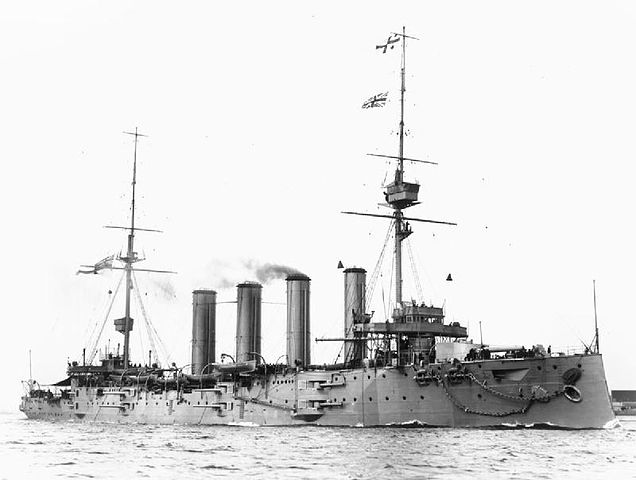
HMS Good Hope
Launched in 1903 after having been laid down in four different arsenals (John Brown, Govan at Fairfield, Vickers-Barrow, and Pembroke naval Yard), in 1899, launched in 1901, these were significantly larger than their predecessors Diadem and Cressy in response to criticisme about these “sub-par armoured cruisers”. They were significantly larger, twenty meters longer and 60 cm wider, resulting in a displacement of 14,000 tonnes instead of 12,000. They were in the same vein as the “Powerfuls” launched in 1895. These were made for naval superiority in their category. They could also flee pre-dreadnought if needed, thanks to their speed of 23 knots. Their armor, however was unchanged, and their main armament still included two 9.2 in (234 mm) main guns plus a double volley of eight 6-in (152 mm) guns in twin barbettes.
To reduce their surface area available to enemy fire, all superstructures were reduced to a minimum, like the large fans/windsocks of previous classes, the deck and hull were revised, without harming nautical qualities. They had four additional 6-in guns compared to these predecessors, placed in twin lateral barbettes. But this system present a major drawback in heavy weather, blinded by water spray and waves for the lower battery. Their usefulness was greatly compromised. Machines made the best so far, procuring the greatest speed for any cruuiser in the world, and they were also the most powerful cruisers ever built to that point. During trials under forced heat they did not manage to exceed 23 knots, except HMS Drake, which managed to maintain 24.1 knots for a few hours. Generally speaking, they were good walkers, capable of sustaining 23 knots for 5-6 consecutive hours.
Drake, Good Hope, King Alfred and Leviathan served for the first two in the Home Fleet, then transferred as flagships of squadrons in 1914, Leviathan was at the China squadron, until replacement in 1906 by King Alfred.
Good Hope was sent to the Falklands squadron at Port Stanley, in order to control the passage of the “cape of storms”, the cape of good hope. She then bore the mark of Rear-Admiral Sir Charles Cradock, nicknamed the “old gentleman”, and adored by his men, ordered to intervene against the incoming squadron of Count Graf Von Spee (the German Pacific squadron), which included, in addition to light cruisers, the formidable armored cruisers Scharnhorst and Gneisenau.
She was sunk during this famous battle. See the First Battle of the Falklands.
The second loss of the war was HMS Drake, torpedoed by U79 in 1917. The other two were BU in 1920, after 19 years of service.
Technical Specifications
Displacement & Dimensions 14,150 t, 17,000 t PC, 162.6 x 21.74 x 7.92 m
Propulsion 2 propellers, 4 4-cylinder turbines, 43 Belleville 30,000 hp boilers. and 23 knots max.
Armor Belt 152, Battery 140, Barbettes 152, turrets 152, blockhouse 305mm, bridges 50mm.
Armament: 2 x 234 (2×2), 16 x 152 guns, 14 x 76 guns, 3 x 47 guns, 2 x 457mm TLTs (sub sides)
Crew 900
 Monmouth class (1901)
Monmouth class (1901)
Monmouth, Bedford, Essex, Kent, Berwick, Cornwall, Cumberland, Donegal, Lancaster, Suffolk
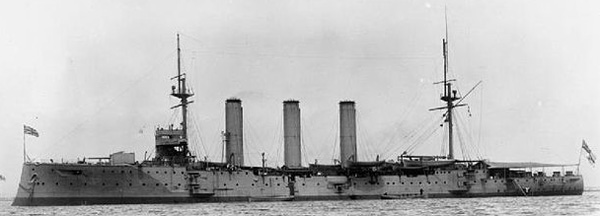
HMS Donegal
The armored cruisers bearing regional names responded to the need for well-armed and protected but less expensive ships, especially compared to previous Drakes. The concern was to produce larger series of cruisers, cheaper than the previous Drakes, with a total of ten laid down in 1899-1901, largest serie of armoured cruiser ever built (only close to the Italian Garibaldi, mostly exported). Unfortunately in this race to to stay below the 9,800 tonnes mark, certain sacrifices were made in terms of armor and armament, which opened up numerous criticisms. So much so that they came to be regarded as second-class armored cruisers, as evidenced by the too easy destruction of Monmouth in a duel with the Scharnhorst, although of the same category on paper.
One of these criticisms, also the cause of Monmouth’s loss, was the ineffectiveness of the low barbettes, totally unusable in bad weather (which was the case) and an innovative, yet unreliable electric guidance. The twin turrets also appeared too heavy and cramped. The armor configuration was inspired by that of the Cressy class, but reduced in places, particularly at bridge level. The weight of the turrets compared to their hull height and lower draft gave them quite an excessive metacentric height, causing higher roll than expected. However, they were good walkers with only three failing to reach trials nominal speed. HMS Suffolk managed to reach 24.7 knots even.
HMS Bedford served in China from 1907 to 1910, and was lost at that time when she struck the reef of Quelpart Island in the China Sea. 18 men were lost during the rescue, and her hull was BU some time later. HMS Berwick collided violently with HMS Tiger in 1908 during night exercises near the Isle of Wight. She essentially rammed and sank her. After an overhaul at Portsmouth, she joined the East India base of the 4th Cruiser Squadron. She then served as a training ship for the North American base from 1912 to 1914. At the time of the declaration of war, she began patrols in the South Atlantic and in September captured the German cargo ship Spreewald. It then carried out patrols and escorts until the end of the war and was discharged in 1919.
HMS Cornwall ran aground at Cape Sable, Nova Scotia while attempting to rescue the struggling HCMS Niobe in 1911 and underwent lengthy repairs in Halifax. She was ready for the Spithead Grand Review of June 1914 and was deemed fit for service, and assigned to the 5th Cruiser Squadron. He captured the German cargo ship Syra, then was detached to the South Atlantic to the Falklands squadron. She carried out patrols between Madeira and Pernambuco, a busy trade route.
After the disastrous Battle of Coronel, she joined HMS Glagow in barring the way to Von Spee’s squadron. She spotted and sank KMS Leipzig on November 8, 1914. She was then detached for operations against Cameroon and on the southwest African coast. From there, she crossed the cape and reached East Africa, then the Red Sea via the Suez Canal and Dardanelles front. She then left for the Hong Kong base and returned in 1917 to escort convoys in the North Atlantic. It had also been rearmed, like most cruisers of her class at that time, with four 6-in guns taken from the lower battery and raised on the upper deck, while remvbing those of the lower battery and the ports welded shut.
HMS Cumberland was sent to the outbreak of war in West Africa. Based in Duala, he captured 10 German cargo ships. She spent the rest of his career from January 1915 in mainland France, carrying out patrols and escorts with the 6th Cruiser Squadron in the North Atlantic.
HMS Donegal served in China and ran aground on an uncharted reef off the coast of Suez. Repaired in Chatham, she was then based at Devonport until 1909 before leaving for Gibraltar with the 4th Cruiser Squadron. She collided with a freighter Volturno, then destroyed her with her artillery for training. She was based at the time of the war in Sierra Leone with the 3rd Wing. In January 1915 she joined the 6th squadron with the Grand Fleet. Then she switched in November with the 7th squadron to escort convoys to Arkhangelsk. During the Battle of Jutland, she was assigned to the 2nd Wing then the 9th, and in 1917 carried out escorts in the North Atlantic.
HMS Essex served in the West Indies in 1914. She was then sent to the North Atlantic until November 1916, capturing two German freighters, then returned to the West India station. From January 1916 she was based at Caranres, capturing another freighter, and remained there until the end of the war.
HMS Kent served in China and was based in the Falklands within Admiral Cradock’s squadron in August 1914. She was detached but took part in the second battle of Coronel on December 8, sinking the KMS Nürnberg. Spotting KMS Dresden, she destroyed and sank her off the coast of Mas a Fuera in Chile. Then based in China, she returned to mainland France in May 1915 and served as an escort until the end of the war, returning to China again and by 1919 supporting Japanese-American operations against the Bolsheviks in Vladivostok. She returned to Hong Kong until her retirement in 1920.
HMS Lancaster served in the Mediterranean and the West Indies before 1914. In January 1915 she joined the 7th squadron of the Grand Fleet in mainland France. From 1916 to 1918 she was then based in the Pacific, then grounded in 1919 at Birkenhead.
HMS Monmouth served in China, then was based at Pernambuco in August 1914. She was quickly assigned to Sir Charles Cradock’s 5th Squadron in the Falklands and took part in the Battle of Coronel on 1 Nov. 1914. Her secondary artillery was totally ineffective in heavy weather and she was sunk by Von Spee’s squadron without any survivors.
HMS Suffolk served for a long time in the Mediterranean. On the eve of the war, she was based in the Falklands in the 4th squadron under the orders of Rear-Admiral Cradock, whose mark he bore. In August she passed through Pernambuco, and participated in the hunt for the cruiser KMS Karlsruhe. From 1915 to 1916 she was based in the Pacific, then in China, until 1918. In 1919, she was sent to support the Japanese-American forces in Vladivostok against the Russian Bolsheviks. Back in mainland France, she served as a training ship until 1920.
Technical Specifications
Displacement & Dimensions 9100 t, 9800 T PC, 141.2 x 20.12 x 7.6 m
Propulsion 2 propellers, 2 4-cylinder machines, 31 Belleville boilers, 22,000 hp. and 22 knots max.
Armor Belt 102, Barbettes 120, turrets 120, blockhouse 280, bridges 51 mm.
Armament 14 guns of 152, 10 of 76, 3 of 47, 2 TLT of 457mm (SM).
Crew 678
 Devonshire class (1903)
Devonshire class (1903)
HMS Devonshire, Antrim, Argyll, Carnarvon, Hampshire, Roxburg
These 6 cruisers were an attempt to improve on the Monmouth characteristics while maintaining acceptable dimensions and tonnage. For the rest, nothing really changed, neither the armament which remained identical (in fact, main guns moved to 7.5 in (190 mm) nor machinery, with a lower speed due to increased displacement. They all had different boilers, and were considered good runners, exceeding their planned speeds during testing. These ships had a slight increase in armor at the waistline, but the rest was unchanged and quite light.
After their completion, these ships were based in territorial waters within the Home Fleet, apart from HMS Carnarvon which was assigned to Gibraltar for 2 years and the Hampshire which did the same in 1911 then moved to Hong Kong in 1912.
HMS Antrim captured a German freighter on August 6, 1914, then within the Grand Fleet. On October 9, she narrowly escaped being torpedoed by an unidentified U-boat. She joined Arkhengeslk in June 1916, then left for stations in South America and then the Indian Ocean. She returned to mainland France in December 1917, was stationed in reserve then returned to service in August-September 1918 before being put back in reserve, then transformed into an experimental ship for the Asdic in 1919. She became a cadet training ship until in 1922.
HMS Argyll captured a German cargo ship on August 6, 1914 but ran aground on Bell Rock Reef on October 28, 1915. She was evacuated by her crew without losses, but reduced to a wreck.
HMS Carnarvon captured a German cargo ship, then assigned to Cape Verde in August 1914. She was before Montevideo in October, and led a squadron to the Falklands in December. She suffered significant damage on the Abrolhos reefs and was repaired in Rio. It was then assigned to North America, then to the Indian Ocean until 1918 and sold in 1920.
HMS Devonshire captured a German freighter in the Atlantic in August 1914 and was then assigned to Scapa Flow, then to Norway. From December 1916 to November 1918 she was assigned to the East Indies, then sold in 1921.
HMS Hampshire captured a German cargo ship in August 1914 and participated in the hunt for the Graf Spee squadron and the Emden. He then returned to mainland France within the Grand Fleet, then was sent to the White Sea to escort convoys to Russia. She took part in the Battle of Jutland as part of the 2nd Cruiser Squadron, and later took Lord Kitchener and his staff on a secret mission to Russia. On June 5, 1916 she hit a mine off Shetland and sank quickly, leaving only 12 survivors.
HMS Roxburg captured a German cargo ship at the start of the war, and was torpedoed on June 20, 1915, but survived. Repaired, she served from April 1916 in Norway. She was then assigned to the East India and North America Station from September 1916 to the Armistice, escorting co-voyages. As such, she managed to ram and sink the U89. She then served as a test ship at Portsmouth before demolition in 1920.
Technical Specifications
Displacement & Dimensions 9,600 t, 10,850 t PC., 144.32 x 20.9 x 7.3 m
Propulsion 2 propellers, 2 mach. 4 TE cylinders, 21 boilers, 21,000 hp. and 22 n. max.
Armor Belt 152, Battery 105, Barbettes 152, turrets 76, blockhouse 305, bridges 60 mm.
Armament 4 guns of 190 (4×1), 6 of 152, 2 of 76, 18 of 47, 2 TLT of 457mm (SM).
Crew 655
 Duke of Edinburgh/Warrior classes (1904-05)
Duke of Edinburgh/Warrior classes (1904-05)
Duke of Edinburgh, Black Prince, Warrior, Achilles, Cochrane, Natal

The Duke of Edinburgh (DuE) and Black Prince were authorized in the 1902 program and the first designed by Philips Watts. At the same time, tonnage restrictions were abandoned, and these ships reached figures well above the previous Devonshires. They also returned to a secondary artillery in central battery at the level of the lower barbette deck. The six 9.2 in (234 mm) returned in single turrets, in a configuration allowing a broadside of four broadside, three in chase and same in retreat. They were later criticized for the too low level of their battery, which suffered from poor aiming in heavy weather. As for the old Hotchkiss 47 mm guns they were considered weak and not fast against new light units.
The Warrior class that followed also included HMS Achilles, Cochrane, and Natal. These ships were virtually identical to the first in terms of machinery, size and displacement, as well as armament, although distribution was different: Thus the 152 guns gave way to 7.5-in (192 mm) in four single turrets. The problem of their accuracy in heavy weather disappeared. These ships were operational in 1907 with some minor armor modifications. Due to their rearrangements, they had a lowered metacentric point and much better stability.
HMS Black Prince was stationed in the Mediterranean. She captured a German freighter in the Red Sea, then operated from Gibraltar. In December she returned to join the Grand Fleet. She fought at Jutland and was sunk by German battleship fire during the night action of May 31, losing her entire crew in her sinking.
HMS Duke of Edinburgh was also based in the Mediterranean in 1914. She captured cargo ships in the Red Sea and operated in the Persian Gulf before joining the Grand Fleet in December. Like Black Prince, she was modified for armament and fittings. She took part in the Battle of Jutland, survived, then was assigned to escort the Atlantic convoys. In 1918 she was posted to the East India and North America Station, and was sent to Imingham in 1919 before being decommissioned.
HMS Achilles was at Portsmouth in 1914. A cannon explosion sent her under repair until June 1916: She therefore missed the battle of Jutland. After that, she was assigned to the Atlantic. She destroyed the German commerce raider Leopard, sank her in the North Sea on March 16, 1917. She remained on escort missions until the armistice then became a bunker training ship.
HMS Cochrane was based at Scapa Flow and fought in Jutland. She was then based in the East Indies, then escorted the convoys to Arkhangelsk. She hit a reef in November 1918 and was scrapped.
HMS Natal was based at Scapa, and was modified at Comarty in 1915. She suffered a fatal accidental cordite explosion on 31 December 1915, causing 505 casualties.
HMS warrior Served in the Adriatic in 1914. She blocked the passage to Goeben to Pola. She defended the Suez Canal. She was then posted to Gibraltar, Sierra Leone, then returned to the Grand Fleet. She fought in Jutland and was seriously damaged, and towed by Engadine, still capsized and sank en route.
Technical Specifications
Displacement & Dimensions 12,200 t, 13,550 t PC, 154.03 x 22.40 x 7.62 m
Propulsion 2 propellers, 4-cylinder TE machine, 25 boilers, 23,000 hp. and 23 knots max.
Armor: CT 254, battery 152, belt 152, internal armor 100, decks 20 mm.
Armament: 6 x 254, 4 x 190, 23 x 47, 3 x 457 mm TLT guns.
Crew 712
 Minotaur class (1906)
Minotaur class (1906)
HMS Minotaur, Defence, Shannon
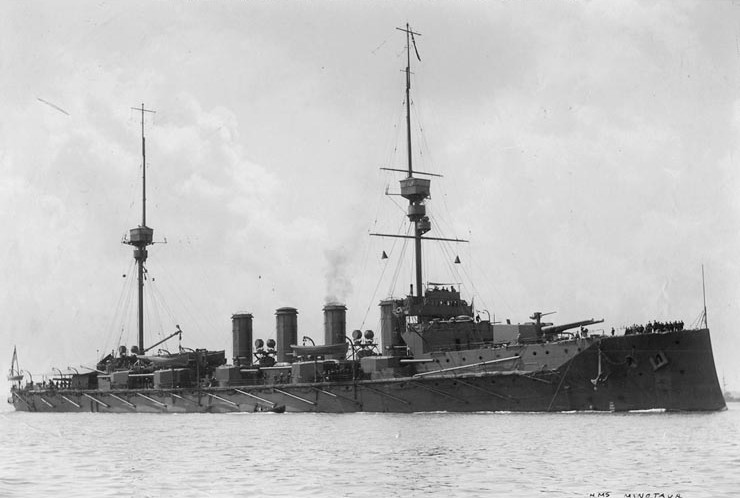
The last British armoured cruisers, the three Minotaurs marked a further milestone towards overpowering artillery, to the detriment of protection, with greater tonnage and dimensions. The secondary cannons were distributed in single side turrets, but with a width of almost 23 meters and a “diamond” shape, the field of fire towards the front or rear of these remained remarkable. The hull of HMS Shannon was also 30 cm wider, with a still reasonable 22.5 knots speed, a bit more than the contemporary HMS Dreadnought. The side armor had been significantly reduced, but that of the two armored turrets and communication shafts reinforced. The funnels were a little shorter, which in relation to the height of the steering positions was advantageous, but posed problems for the bridge’s visibility in a tailwind. The funnels were raised in 1909 by 4.50 m, while in 1917, Minotaur and the Shannon received tripod masts and reduced light armament, replaced by a 3-in mm AA gun.
For these three ships accepted into service in 1908, their career during the Great War was active:
HMS Defense was based in China in 1912. In 1914, after having served for a long time in the 1st cruiser squadron, she was in the Mediterranean. She thus participated in the hunt for the Goeben and the Breslau, the German Mediterranean squadron, then operated in the Dardanelles. She then joined the Falklands and Admiral Cradock’s squadron. Unfortunately, she was not present in the squadron at the Cape of Good Hope when Sir Charles Cradock had to confront Count Spee in November. In 1915, she became flagship of the 1st Cruiser Squadron within the Grand Fleet. On May 31, 1916, she was in line during the Battle of Jutland. She was hit by the battleship Friedrich der Grösse, and a shell exploded in an ammunition well. The burning cordite blew up the hold and the ship with it. There were no survivors.
HMS Minotaur was based in China from 1910 to 1914. She returned to mainland France carrying Australian troops. She was then flagship of the Cape of Good Hope squadron before joining the Grand Fleet, then underwent long overhaul. In 1916, she was assigned to the 2nd Cruiser Squadron and participated in the Battle of Jutland. She was discarded and sold in 1919.
HMS Shannon served in the 2nd cruiser squadron in 1914. She had a refit at Cromaty, then took part in the Battle of Jutland. In November, she was escorting convoys to Murmansk. Then she escorted convoys in the North Atlantic until her retirement in 1920.
Technical Specifications
Displacement & Dimensions 14,100 t, 14,600 t PC, 158.2 x 22.7 x 7.92 m
Propulsion 2 propellers, 2 4-cylinder machines, 24 Yarrow boilers, 27,000 hp. and 23 knots max.
Belt armor 152, Barbettes 180, turrets 203, blockhouse 254, bridges 20 mm.
Armament: 4 x 234 guns (2×2), 10 x 190 guns, 16 x 76 guns, 5 x 457mm TLT (SM).
Crew 755
British 2nd/3nd class Cruisers
 Iris class despatch vessels (1877)
Iris class despatch vessels (1877)
Iris, Mercury
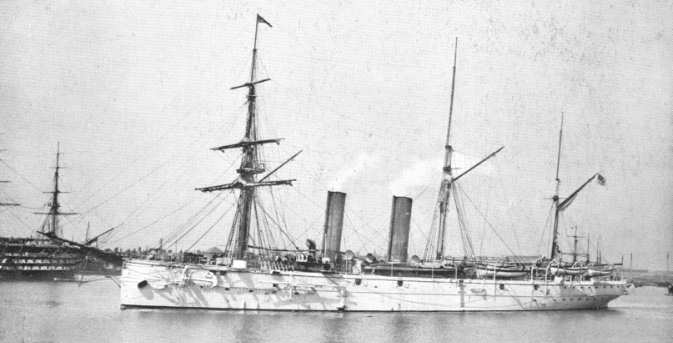
HMS Mercury in the 1880s. Unlike her sister she lacked the clipper bow and receiced a white colonial livery, then had her masts removed and was painted grey from 1914
It is generally argued as frigates and dispatch vessels both counts as ancestors of cruisers, and the 1877 Iris class, laid down in 1875 was the earliest example of 3rd class cruisers of the RN at this point. They were also the first built in steel, masted vessels armed with thirteen broadside 5-in BL and four 3-pdr QF as well as four torpedoes carried. Protection was very limited, but they were able of 17 kts, remarkable at the time. Of course neither were operational as cruisers in 1914. They are signalled only because HMS Mercury was still listed in 1920, her sister stricken in 1905. Indeed when WWI broke out, Mercury served as submarine depot ship and during the war, as utility hulk at Chatham.
 Leander class cruisers (1883)
Leander class cruisers (1883)
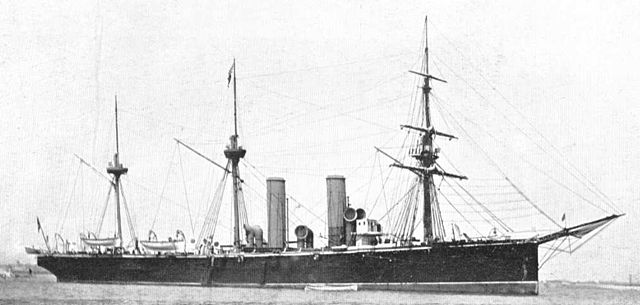
First cruisers of the name and laid down as 2nd class vessels in 1880-81, HMS Arethusa, Amphion, Leander and Phaeton were much larger than the Iris at 4300t, and carried ten 6-in BLR and 16 machine guns plus four torpedo tubes above the waterline. They were masted but with their machinery, were capable of 16.5 knots. Again, they were no longer active as such in WWI. Amphion was sold for BU in 1906, Arethusa in 1905, but Leander survived as depot ship from 1904, sold in 1920 while Phaeton was sold in 1913 as the training ship Indefatigable, and still listed in …1941. She was repurchased as Carrick II and went on in her trailing duties until 1947. Quite a life.
 Mersey class cruisers (1885)
Mersey class cruisers (1885)
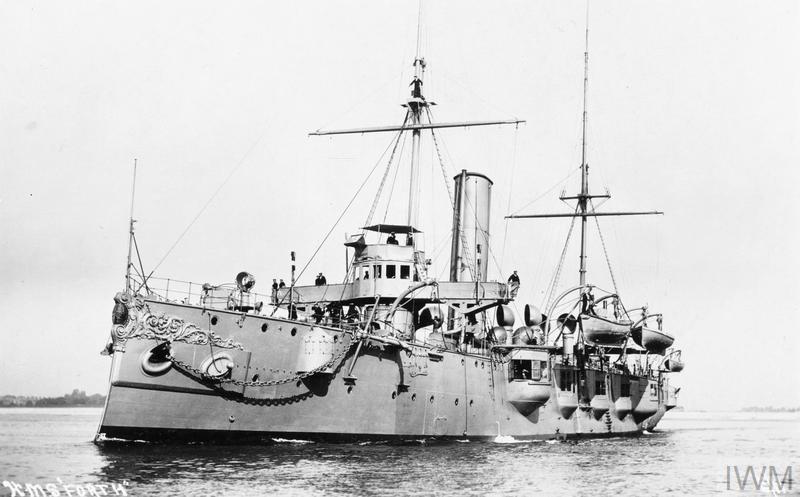
HMS Forth modernized, converted as depot ship before WWI.
Smaller types of 2nd class cruisers unlike those seen before, they were two-masted, 4050t, wider, and with heavier guns: Two 8-in BLR, ten 6-in, three 3-pdr, nine MGs and two torpedo tubes. The class comprised HMS Mersey, Severn, Thames and Forth. The first two were sold in 1905, but HMS Thames served as a depot ship like her sister. She was sold in 1920 as the TS Botha, based at the cape and as accomodation ship in 1942-45, then discarded and BU in 1947. Her sister was sold in 1921.
 Marathon class cruisers (1888)
Marathon class cruisers (1888)
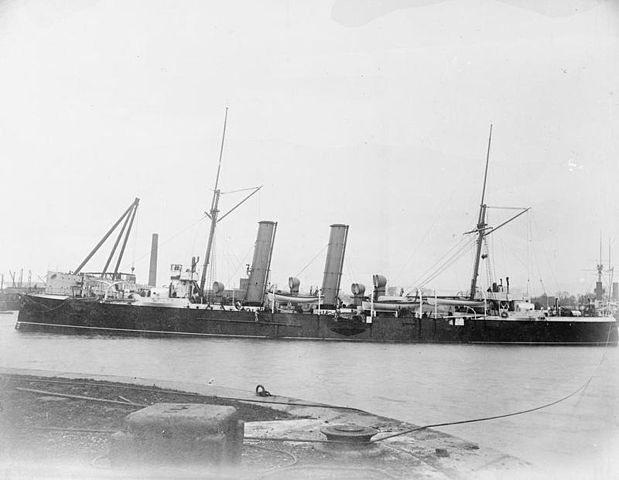
HMS Medusa as built
five of these 2nd class cruisers were built in 1887-90: HMS Marathon, Magicienne, Medea, Melpomene and Medusa. These were even lighter than previous vessels at 2800t, with some converted for colonial duties and fully sheated rising to 2950t. Still they were capable of 20 kts, and carried six 6-in guns, nine 6-pdr andf one 3-pdr plus four torpedo (two launchers, two in cradles). Marathon, Magicienne and Melpomene were sold in 1905, but HMS Medea manage to serve as until sold before the war in 1914, and Medusa manage to survive as depot ship until 1920. Their design was influencial in helping shaping out the next “mass built” Apollo class, but they had engine troubles and were too cramped.
 Apollo class (1890-91)
Apollo class (1890-91)
21 made: Latona, Melampus, Andromache, Sirius, Terpsichore, Naiad, Pique, Thetis, Sybille, Apollo, Tribune, Spartan, Defiance, Indefatigable, Rainbow, Sappho, Intrepid, Brilliant, Retribution, Scylla, Aeolus, Iphigenia.
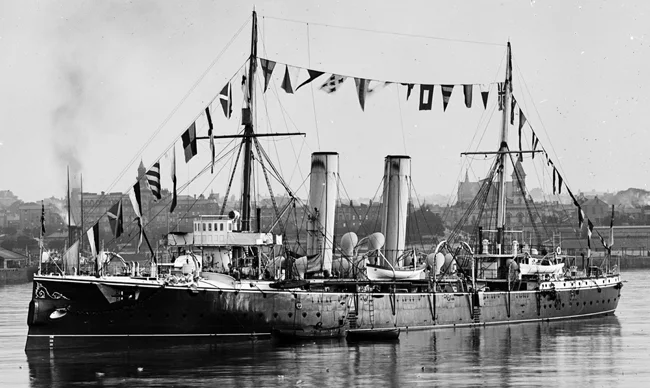
Here again, these cruisers were on their way to retirement at the start of the century, with at the time Admiral Jackie Fisher pushing for their retirement as a waste of money. In all, these were 21 cruisers. The Apollo class was the largest series of cruisers ever undertaken in the 19th century. These were light ships, called “second class”, and were designed to operate on distant stations as super-gunboats. They had been ordered by the Naval Act of 1889, and they were ordered from ten different shipyards on similar plans, in order to save construction time: Devonport, Chatham, Sheerness, London and Glasgow, NCA Co Barrow, Palmer, Samuda, Thompson, and of course Armtrong Elswick.
They were also perfectly representative of export cruisers, and were used in many countries, including the USA. They were essentially derived from the Medea class of 1887, but with redesigned rapid-fire armament. Instead of having six 6-in guns, they only had two, relegated to the both ends in axis. On the other hand, they used faster 5-in mm guns housed on behind bulwarks. Their 6-pdr guns were distributed into four front and rear hull barbettes, the others on the sides. However, this arrangement was widely criticized: The side guns in particular did not extend beyond the hull and their firing arc was much reduced. In fact, when in chase or retreat, their firepower was strictly limited to one 6-in gun only. Two torpedo tubes were located in the battery deck at the rear mast and had a clearance of 90°. The other two were fixed in the axis, at the stern and at the bow.
The armor was very classic, limited to 5-in or 120 mm and for key locations, the conning tower forward having 80 mm walls, and the internal longitudinal bulkheads around the engine room 5-in also. The main guns had 4-in or 100 mm shields. Everywhere else it was reduced to 1 to 2-in or 51-20 mm. The two engine rooms, using a vertical configuration, were separated by a longitudinal bulkhead to prevent flooding as well as a serie of the usual transverse bulkheads, but no double hull.
They were capable of cruising for 8,000 nautical miles at 10 knots, with a maximum speed similar to the Medea. They were also considered good walkers. However, their light construction was a handicap in terms of seakeeping in heavy weather. With a very low freeboard they were therefore too “wet”, and became poor firing platforms. 10 cruiser (Aeolus, Brillant, Indefatigable, Intrepid, Iphigenia, Pique, Rainbow, Retribution, Sirius, Spartan) were defined specifically as colonial cruisers and their structure was abundantly sheated with copper and wood rather than steel, subject to rust, thereby weighing 200 tonnes more and with reduced speed.
7 ships were taken in hand for transformation into minelayers in 1907-1910: Andromaque, Apollo, Intrepid, Iphigenia, Latona, Naiad and Thetis.
HMS Indefatigable was transferred to the Canadian Navy in 1910 and remained in service until 1920 almost unchanged, renamed Melpomene. 8 ships were no longer in service in 1914. HMS Sybille was lost at sea in 1901, and 7 others decommissioned in 1911-14.
Sirius, Thetis, Iphigenia, Intrepid, and Brilliant served as obstructors in the Zeebrugge operations in 1918, sunk on April 23 in order to block the port. The others, more or less inactive, served as depot ships until the end of the war or as “sentinels” in distant second-rate stations. The minelayers, on the other hand, set up a barrage of 9,000 mines in 22 sorties, helping to isolate the High Fleet. They were decommissioned in 1920-22.
Technical Specifications
Displacement & Dimensions 2900t, 3400-3600 T PC, 95.7 x 13.31 x 5.63 m
Propulsion 2 propellers, 2-cylinder TE machine, 5 boilers, 7,000-9,000 hp. and 18.5 – 20 knots max.
CT 76 mm, shields 100 mm, internal armor 120 mm, bridges 51 mm.
Armament: 2 cannons of 152 mm, 6 of 120 mm, 8 of 57, 1 of 47, 4TLT of 355mm.
Crew 273
 Astraea class (1893)
Astraea class (1893)
Bonaventure, Astraea, Charybdis, Cambrian, Flora, Forte, Fox,
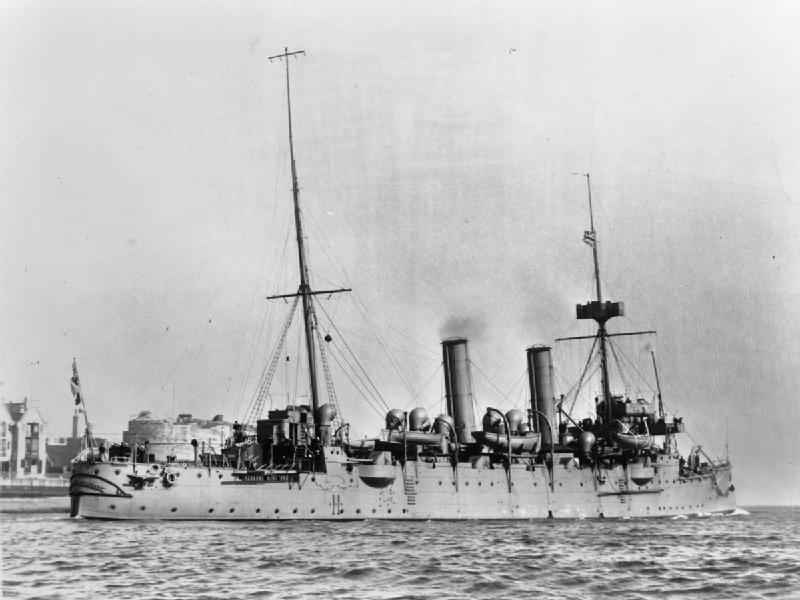
The Astraea class directly followed the Apollo. In particular, attempts were made to remedy a certain number of issues. An additional 1,000 tonnes had been allocated to the redesign of the hull and more powerful, better distributed armament. This resulted in eight vessels made in Devonport, Sheerness, Pembroke, Chatham and Portsmouth, much more massive than the Apollo. The bow was in fact, like the stern, raised for seakeeping, the hull widened and lengthened, and above all the lateral artillery was carried a deck above. The heavy guns were now four, placed on corners and secondaries on extensions which allowed firing in both chase and retreat. The propulsion system included a three-cylinder, triple-expansion engine coupled with eight cylindrical boilers. This provided 7,500 hp in normal conditions, 9,250 when forcing heat, for 20.5 knots in the best case, which was hardly superior to the Apollo.
On the other hand, the autonomy increased, increasing to 7,000 nautical miles at 10 knots. All of these ships were extensively constructed and finished using copper and wood, with an eye toward use in the tropics. They were criticized, however, despite the undeniable better sea behavior and the greater efficiency of the artillery pieces away from the sea spray, for the little progress made in firepower and armament, at a much higher tonnage and budget.
All these ships were in service in August 1914, but with very different situations:
HMS Bonaventure had been converted into a submersible supply ship in 1907 at Devonport, after having served in the Pacific, and being broken up in 1920
HMS Astraea operated in the Far East (Hong Kong, Colombo) before returning to the home fleet in 1911. She was sent to South Africa in 1913. In 1914 she was shelling Dar-es-Salaam, then tracking down the German cruiser Königsberg, and blocking her in the Rufiji delta. She was stricken in 1919.
HMS Cambrian served in Australia, then Colombo, before returning to Devonport. She made a few trips, but was taken over for conversion in 1915, and became a training ship, under the name Harlech.
HMS Charybdis was successively placed in reserve and withdrawn to serve until 1914, in mainland France. In 1915 she was involved in a collision in Bermuda. She remained there until 1917, then served as a cargo ship until 1918, leased from Mars to a private company. She was finally BU in Holland in 1923.
HMS Flora served in the Far East. In 1914 she was decommissioned, but remained in port as utility pontoon, renamed Indus II in 1915, and finally broken up in 1922.
HMS Forte served in Cape Town, South Africa, then in Portsmouth, and again in Cape Town. Relieved Hermione in 1914. She returned to Chatham in 1913, and was placed in reserve, sold for scrapping in 1914 in the Netherlands.
HMS Fox also served in the Far East (East Indies), but returned to Portsmouth and placed in the reserve fleet. Her career was then more active: She served again in the East Indies, notably in Muscat, then in the Mediterranean in Aden, and again in Colombo in 1914. She captured 2 German cargo ships, returned to the Mediterranean, then reached the Red Sea. She was still there in 1918. She served in home waters before being stricken and BU in 1920
HMS Hermione was placed in reserve in 1906, and then sent to Cape Town. She was wrecked at Zanzibar, but the damage was light, so she was quickly repaired. She then served in the Home Fleet, operating in the Atlantic. Then during the war she became a coast guard, then launches base/barracks depot ship until 1919. She sold and became the civilian training ship Warspite.
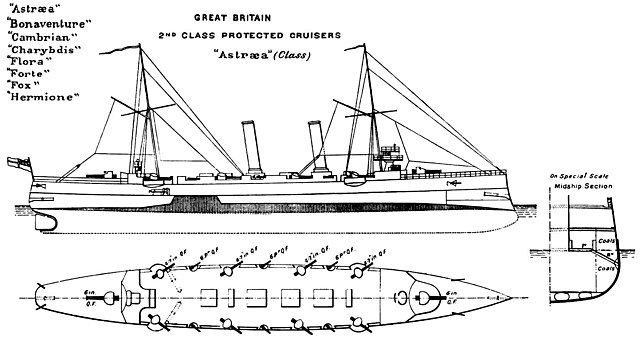
Technical Specifications
Displacement & Dimensions: 2900t, 3400-3600 T PC, 95.7 x 13.31 x 5.63 m
Propulsion: 2 shafts 2-cylinder TE machine, 5 boilers, 7,000-9,000 hp. and 18.5 – 20 knots max.
Armor: CT 76 mm, shields 100 mm, internal armor 120 mm, bridges 51 mm.
Armament: 2 cannons of 152 mm, 6 of 120 mm, 8 of 57, 1 of 47, 4TLT of 355mm.
Crew: 273
 Eclipse class (1895)
Eclipse class (1895)
Dido, Diana, Doris, Eclipse, Isis, Juno, Minerva, Talbot, Venus
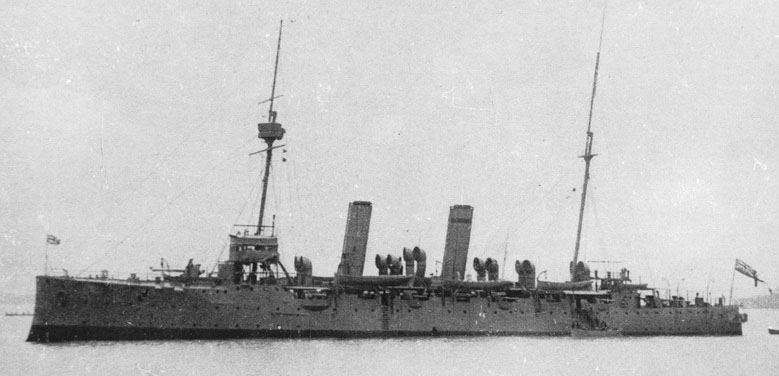
This series of 9 so-called “second class” cruisers derived from the Astraea, but remedied their main issue, a still weak artillery. They were ordered to the 1893-94 with plans provided by Spencer, started in 1893-94 and completed in 1897-98. The hull was enlarged and reinforced, the forecastle provided with a turtle-back deck. The artillery had also been rearranged so as to allow a more effective volley in both chase and retreat. However, it was considered that the armament was still too weak and it was decided to rearm them in 1903-1905 with the exception of HMS Eclipse, which had an armament including five 6-in, six 5-in, eight 3-in, six 6-pdr mm original. The machinery hardly changed but some progress had been made with a relative gain in power and consequently their speed during testing was 20 to 21.5 knots. These were the first second-class cruisers equipped with military topsails.
Apart from HMS Dido which was decommissioned and used as a supply ship in 1913 (and BU in 1926), all the others had an active career during the war:
HMS Diana was based in the Mediterranean, but was at Devonport in 1914. She was assigned at Force G in the round, capturing a German schooner. She was then assigned to the 12th Light Squadron until 1915. Then in November, left for the Chinese station of Hong Kong, and remained there until 1917. He was then based in Suez, then operated in the Red Sea, and in the Indian Ocean. She was sent to Queenstown until his end of service in 1919.
HMS Dido was assigned to various squadrons in mainland France. After an overhaul at Chatham, she underwent a collision with the Berwick in 1913. Repaired, she was then based at Harwich until 1916. She then became the supply ship of the 10th Destroyer Squadron until the armistice.
HMS Doris was based with the Home Fleet in 1914, operating sorties and capturing some German cargo ships. He was then sent to the Mediterranean with the 11th squadron. He attacked Turkish merchant traffic, sinking a cargo ship. He was then sent to the Dardanelles and then to the Aegean Sea. In 1917 she was based in the East India Station and was decommissioned at Bombay in 1919.
HMS Eclipse served as Osborne’s training ship until 1912. She was then detached to Portsmouth then Devonport and escorted the AE1 class submersibles at Singapore to Australia on the eve of the conflict. She then joined Force G in the Channel, capturing 2 German cargo ships. She was then based at the 12th Squadron, then in 1916 detached as a submersible depot ship to Devonport before her retirement in 1919.
HMS Isis served as a cadet training ship at the West India and North American Station before joining the Home Fleet in 1909. After a short refit, she was assigned to the Home Fleet at Devonport. She accidentally hit a freighter, causing the loss of the latter, and in 1914 operated patrols, capturing a German freighter. She was then detached to the Irish Sea, then to Bermuda, and finally back to his youth station, and remained there until the armistice. She was decommissioned in 1919 at Invergordon.
HMS Juno operated in the Home Fleet until 1914 in various formations before being assigned to the 11th Light Squadron in the Irish Sea. In July 1915 she was sent to the Persian Gulf. She was then sent to the East Indies until the armistice and it was disarmed in mainland France in 1919.
HMS Minerva served in the Mediterranean in 1912. Two years later she was at Portsmouth then joined the 11th Squadron in Ireland, then was assigned to the 5th Wing to patrol in front of Finistere. On this occasion she captured an Austrian freighter. She was then sent to the Mediterranean, first to Suez, then to the Dardanelles in 1915. She had the opportunity to fight against the Turkish navy, notably sinking the torpedo boat Demirishar on April 17, 1915 off Chios. She was then sent to China, then the Red Sea and the Indian Ocean in 1917 before ending his career in East Africa. She was decommissioned at Queenstown in 1919.
HMS Talbot served in the Channel, then was sent to Suez, running aground there in 1912. In 1913 she led the 7th Destroyer Squadron. She returned to the mainland at Devonport within the 3rd Fleet then was assigned to Force G in 1914. On this occasion she captured a German cargo ship. Then she joined yhe 12th squadron in February 1915, then the Dardanelles in April. Until 1917, she was then based in East Africa and then based at the Cape of Good Hope in South Africa in 1918, and returned to the Mediterranean in 1919. At the end of 1919 she returned to Devonport to be decommissioned and sold in 1920.
HMS Venus served in the Atlantic and Mediterranean, being based at Pembroke and Portsmouth. In 1914, within the 11th squadron in Ireland, she captured 2 German cargo ships. She was damaged during a hurricane, losing her front mast, and was then based in Egypt, then in Singapore in 1917 before the East Indies in 1918 as flagship of the squadron. She returned to mainland France in 1919 for demolition.
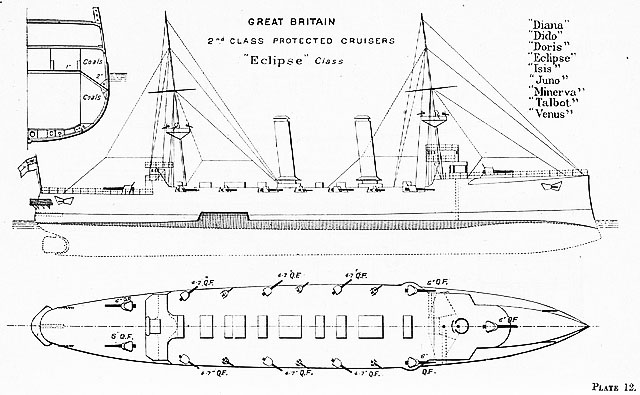
Technical Specifications
Displacement & Dimensions: 5,200t, 5,600 T PC, 113.70 x 16.31 x 6.25 m
Propulsion: 2 shafts, 2x 3-cylinder TE, 8 cylindrical boilers, 8000 hp. and 19.5 knots max.
Armour: Machine protection bridge 15, Shields 76, CT 152, decks 76 mm.
Armament: 11 x 152, 8 x 76, 6 x 47, 3 x 457 mm (sub) TTs.
Crew: 450
 Arrogant class (1896)
Arrogant class (1896)
Arrogant, Furious, Gladiator, Vindinctive
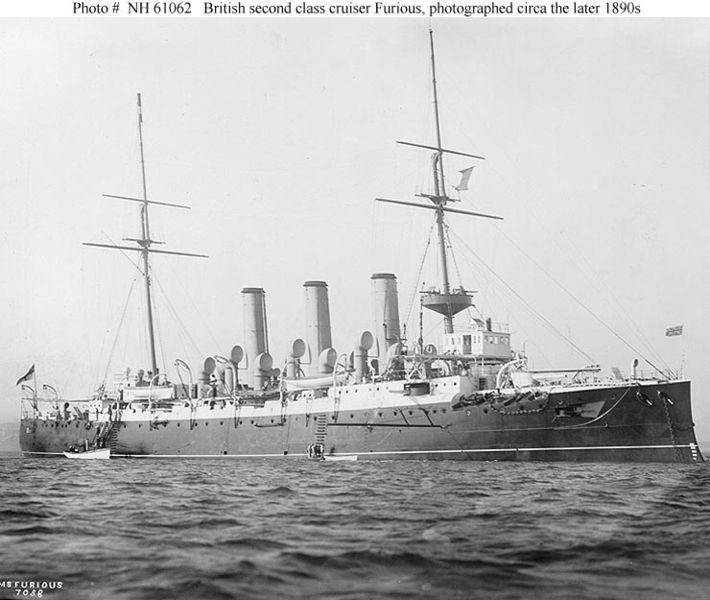
The Arrogant class included four ships, Arrogant, Furious, Gladiator and Vindinctive. They were defined in the 1895/96 plan as fleet units rather than for protecting trade routes. In particular, the admiralty wanted to develop their ramming capacity. To be more agile than the Eclipses from which they derived, they had reduced length but increased width. Thus their displacement remained slightly higher. The rudder was enlarged for extra agilita, with a second added and bot the stern and bow were redesigned. Their armament did not change fundamentally, some 5-pdr (47mm) rapid-fire guns were simply removed and replaced by heavy Vickers machine guns. The armor was also reinforced, particularly forward, and the ram bow reinforced to spread the shock of a ramming. It might seem strange that such a tactic was still in use on the eve of the 20th century, but it was understood that the ramming maneuver was applicable to a ship already in distress, receiving the coup de grace there.
These four cruisers were completed in 1898, 1899 and 1900 for Vindictive. They were the first British second-class cruisers equipped with water-tube boilers, mated to two triple expansion engines. The final speed, however, was lower than expected, and lower than that of previous class cruisers. In 1903-04, their original armament was removed for a more uniform artillery of ten 6-in or 152 mm guns battery.
Their career was limited for the three survivors to being in service in 1914.
HMS Gladiator: On April 25, 1908, she sank following a collision with the American liner SS St Paul on the Solent. She will be refloated for demolition the following year.
HMS Arrogant from 1910 served as a supply ship for submersibles at Devonport
HMS Furious was renamed Forte in 1915 to free the name for Fisher’s new “baltic battlecruiser” and served as a supply ship to HMS Vernon since 1906 then was then attached as a pontoon.
HMS Vindictive was also condemned after inaction: She spent her time alternating between reserve and service from 1906 to 1909. She then received a short overhaul at Chatham, and left for the 3rd Light Cruiser Division. She was then transferred to the 4th, then served for a time as a supply ship for the Vernon in Portsmouth. However, from 1914, August, her career took on a completely different face: Very quickly, Vindictive was employed in the 9th cruiser squadron, where she captured two German cargo ships. From 1915, she left for the South American station (Chilean coast). By 1916 she was back and operating in the White Sea. She returned to the Grand Fleet at the end of 1917.
She then remained at anchor in Portsmouth and was then taken in hand for a very special reconversion: This involved making her the pivot of the famous Zeebrugge raid scheduled for 1918. She was stripped of its masts, all superfluous equipment, her 6-in cannons and secondary artillery to place field artillery there: Howitzers, mortars, and even flamethrowers installed in two towers. Everything had been planned for a lateral assault on the mole and her port side had been reinforced, including armored walkways. The command tower had been reinforced with sheet metal covered with sandbags. Vindictive carried the Royal Marine commandos for the main assault. (see: The Zeebrugge Raid). Hammered by German artillery at point blank range her hull remained intact, so she dragged herself to Portsmouth, reduced practically to a floating wreck. She was later sunk as pontoon to obstruct Ostend where she was scuttled, refloated and BU in 1920.
Technical Specifications
Displacement & Dimensions: 5,680t, 5,750 T FL, 104.24 x 17.53 x 6.1 m
Propulsion: 2 shafts, 2x 3-cylinder TE machine, 18 Belleville boilers, 10,000 hp. 19 knots.
Armour: CT 230 mm, shields 114 mm, internal armor 100 mm, bridges 51 mm.
Armament: 4 x 152, 6 x 120, 8 x 76, 3 x 47.5 ML, 4 x 457 mm TTs.
Crew: 273
 Highflyer/Challenger class (1898)
Highflyer/Challenger class (1898)
Hermes, HighFlyer, Hyacinth, Challenger, Encounter
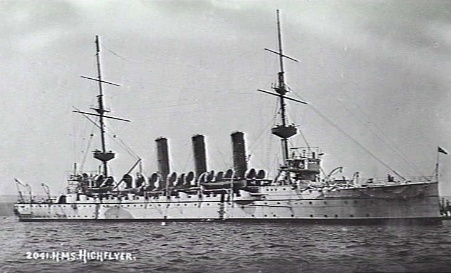 Most authors generally associate the three Highflyers with the two Challengers, although they were built with a gap of 3 years, and included some improvements. The Highflyers were very similar to the previous Eclipses but had a uniform 6-in or 152 mm armament and were more efficient with lighter water tube boilers. Their machines were those of the previous Arrogants, giving them a speed of over 20 knots. HMS Hermes, however suffered from boiler problems, which were replaced. The two Challengers from the 1900 program had more powerful machinery and larger masts. They both exceeded 21 knots. They were the last British second-class cruisers, assimilated to protected cruisers in 1914. Their career was quite active:
Most authors generally associate the three Highflyers with the two Challengers, although they were built with a gap of 3 years, and included some improvements. The Highflyers were very similar to the previous Eclipses but had a uniform 6-in or 152 mm armament and were more efficient with lighter water tube boilers. Their machines were those of the previous Arrogants, giving them a speed of over 20 knots. HMS Hermes, however suffered from boiler problems, which were replaced. The two Challengers from the 1900 program had more powerful machinery and larger masts. They both exceeded 21 knots. They were the last British second-class cruisers, assimilated to protected cruisers in 1914. Their career was quite active:
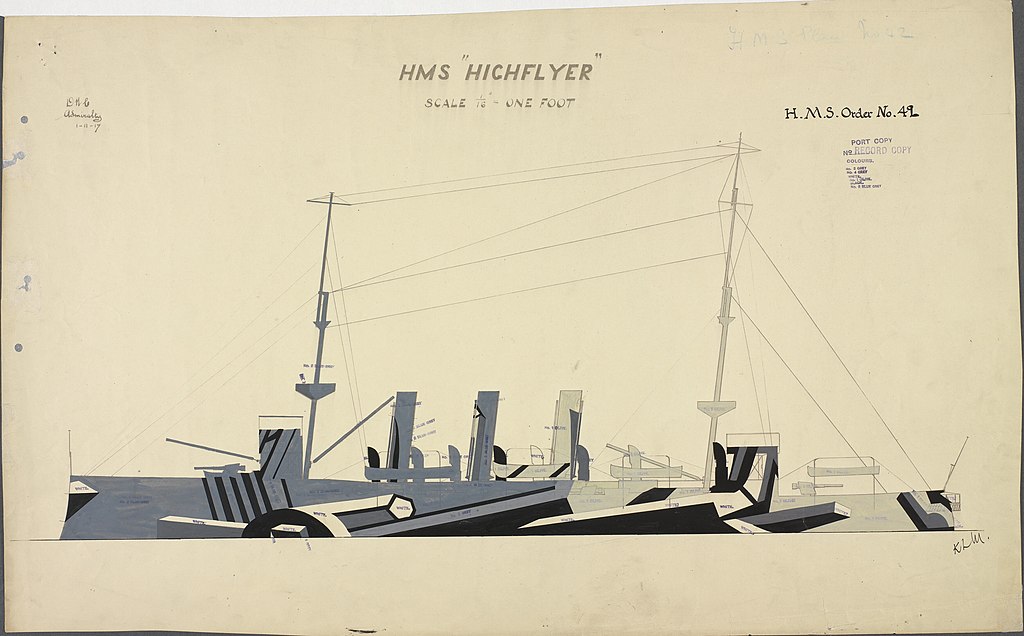
Camouflage pattern for the class, 1917
HMS Hermes was sent to Chatham in 1913 to be converted into a seaplane transport at the instigation of the RFC (she could carry 3). He carried out various tests and trials. At the start of the war, she was urgently rearmed and sent to patrol the Atlantic and the North Sea. She was a victim of the U27 off the banks of Ruylingen on October 31, 1914. She sank slowly, with only 22 drowned.
HMS Highflyer for its part served as a cadet training ship on the eve of the war. In 1914 it was transferred to the 9th squadron, then to the 5th cruiser squadron. She intercepted and sank the auxiliary cruiser Kaiser Wilhelm der Grosse off the Rio d’Oro on August 27, 1914. She was then assigned to Cape Verde, then to West Africa in 1916, to the West Indies. In 1917, in the East Indies in 1918, she remained flagship of the Bombay squadron until 1921.
HMS Hyacinth served in India at Bombay and in mainland France at Chatham before relieving HMS Hermes at Cape Town. in 1913. On April 18, 1915 he captured the German freighter Rubens, which was resupplying the cruiser Königsberg. On March 23, 1916 he bombed Dar-es-Salaam and sank the SS Tabora. He was retired to Portsmouth in 1919.
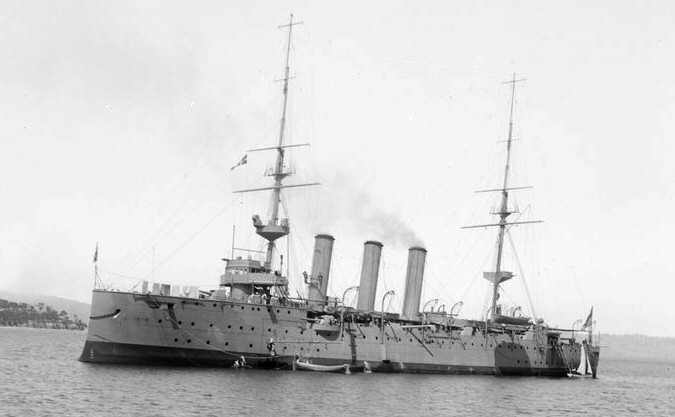
HMS Challenger was serving in Portland with the 9th Squadron in 1914. It intercepted the German freighter Ulla Boog which was attempting to cross the English Channel towards the coast of Africa. She was sent to patrol the coast of Cameroon, a possession of the Reich. She engaged the German cruiser KMS Königsberg in 1915 on the Rufiji, then bombarded Dar-es-Salaam. She spent the rest of his career in West Africa.
HMS Encounter was transferred in 1912 to the RAN. She served in the Pacific until 195, capturing the German freighter Elfriede. In 1916, she was based in Hong Kong, before returning to her station in the South Pacific until 1918. Becoming a barracks ship in 1919 in Sydney, then renamed Pinguin, she survived until 1932.
Technical Specifications
Displacement & Dimensions 5100t, 5650 T PC, 113.4 x 16.4 x 6.2 m
Propulsion 2 propellers, 4-cylinder TE machine, 18 Belleville boilers, 10,000 hp. and 20 knots max.
Blockhouse armor 152 mm, shields 76 mm, internal armor 120 mm, decks 30-80 mm.
Armament 11 guns of 152, 9 of 76, 6 of 47, 2 TLT of 457 mm SM.
Crew 450
British 3rd class cruisers
 Pearl Class (1889)
Pearl Class (1889)
Pallas, Pandora, Pearl, Pelorus, Persian, Philomel, Phoebe, Phoenix, Psyche

Succeeding the Barham class of the early 1880s these vessels were sometimes class as second rate cruisers, or more generally third-class protected cruisers. They designed by Sir William White for the Royal Navy with nine ships included five of paid for by Australia under the Imperial Defence Act of 1887, to serve be based in Australian waters with local crews.
They were lightly armed:
Eight QF 4.7 inch (120 mm) guns, eight QF 3-pounder (47 mm) guns, four Vickers machine guns and two 14-inch (356 mm) torpedo tubes.
2,575 tons for 278 ft (84.7 m) oa x 41 ft (12.5 m x 15 ft 6 in (4.72 m) and two shafts, 3x TE, 4 DE cyl. boilers: 7,500 ihp on forced draught, 19 knots. Crew 217
No longer operational when WWI broke out: All were sold in 1906 but two:
HMAS Persian was Renamed HMS Wallaroo and then HMS Wallington and changed back to original name in 1920 before being sold for scrap.
HMAS Philomel was transferred to New Zealand Navy in 1914. She survived in various roles in the interwar and even WW2, being sold on 17 January 1947, but scuttled on 6 August 1949 as artificial reef.
 Pelorus class (1896)
Pelorus class (1896)
Pactolus, Pandora, Pegasus, Pelorus, Perseus, Pioneer, Pomone, Prometheus, Proserpine, Psyche, Pyramus
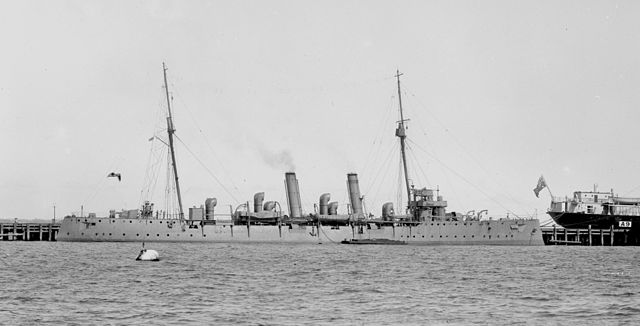
HMS Pyramus in 1914 – coll. SLV Green
The Pelorus class, initiated by the 1895 plan, was a series of third-class ships intended to succeed the Pearl class. However, compared to the latter, they were longer but also narrower, losing almost 400 tonnes. Their armament, on the other hand, remained almost unchanged. The admiralty wanted to give them a more pronounced spindle shape to try to increase top speed, in relation to more powerful machinery reaching close to 1,000 hp. But their low length/width ratio also meant a decline in stability and also more hazardous behavior at sea. In truth these ships were less seaworthy. Furthermore, the armor was also reduced, particularly for the cannon shields. They were all extensively equipped with various water tube boilers, Blechynden, Normand, Reed and Thornycroft. The series included 11 vessels, completed from 1897 to 1901.
Pomone and Pactolus only saw active service for a few years due to their poor boilers (Blechynden), but other ships were also scrapped before WW1, due to recurring boiler problems, most of which struggled to maintain 16 knots after a few years of active service, making them no more valuable than gunboats.
HMS Pandora was decommissioned in 1913, HMS Prometheus in 1914, as was HMS Perseus. Pomone was at anchor as a pontoon and training ship in 1910 at Dartmouth. Pioneer was assigned to the RAN in 1912 and remained in service until 1931 (she was scuttled). Psyche was also transferred to the RAN in 1915. Pactolus had been withdrawn from service in 1912 and was serving as a supply ship at anchor. HMS Pomone was assigned as a training ship in 1910.
The remaining cruisers saw service during the Great War:
HMS Pegasus served in 1914 at the Cape of Good Hope base in August. She then moved to West Africa. Assigned to Zanzibar, she was surprised at anchor on September 20 and sunk by cannon fire by the German cruiser KMS Königsberg.
HMS Pelorus served as an escort and patrol boat in the English Channel in 1914. She was sent to the Mediterranean and converted to a supply ship in 1916 at Gibraltar and discharged in 1920.
HMS Proserpine served in the 7th Cruiser Squadron in 1914 and was subsequently assigned in January 1915 in Alexandria. Until 1918 she served in Mesopotamia and was finally scrapped and broken up at Genoa in 1919.
HMS Pyramus was like Psyche based in New Zealand before the war. He joined the Persian Gulf in January 1915, then was based in the East Indies until 1920.
Technical Specifications
Displacement & Dimensions: 2135t, 2560 T PC, 95.55 x 11.13 x 4.88 m
Propulsion: 2 shafts, 2x 3-cylinder TE, 16 boilers, 5000 hp. 18.5 knots max.
Armor: Shields 12.5 mm, CT 76 mm, decks 51 mm.
Armament: 8 x 102 mm, 8 x 47, 3 x Maxim MGs, 2 x 457 mm TTs.
Crew: 224
 Gem class (1903)
Gem class (1903)
Amethyst, Diamond, Sapphire, Topaze

The “Gem” (or “Topaze”, named after diamonds anyway) were the last British third-class, protected cruisers. They inherited a lineage started with the Surprise class of 1885 and made up of very different different. Much larger than the Pelorus of 1896, with 3,000 tonnes compared to 2,135, they were initially to comprise eight vessels but the second tranche was cancelled as the new scouts seemes more promising. They improved all aspects of the old ships, including armor, speed, armament and autonomy.
Two 4-in or 102 mm rapid-fire guns were placed on the stern and bow in line, the others distributed on the freeboard with overhangs allowing chase or retreating fire of three. HMS Amethyst was the only one of these cruisers to experiment with Parsons turbines, and even was the first British cruiser equipped with these. This system was economical at high speed, but autonomy was reduced. She was also the fastest, with 23.5 knots during trials.
These cruisers were completed in 1904-05 and quite active during the war:
HMS Amethyst did not fight at the Battle of Heligoland Bay in August 1914 as she had just been relieved of her post at Harwich by HMS Arethusa a few days earlier. She was assigned to the 1st Light Wing. Sent to the Dardanelles until 1916, then she served until 1918 in the Falklands.
HMS Diamond served with the 5th Battle Squadron in the English Channel until 1918 before being detached to the Mediterranean, then was transformed into a flagship carrier, and sold in 1921.
HMS Sapphire served with the 4th Battle Squadron, then Mediterranean in 1915-16, before joining the East India station.
HMS Topaze was with the 5th squadron in the English Channel. She then served in the Mediterranean and the Red Sea before being sold in 1921.
Technical Specifications
Displacement & Dimensions: 2700t – 3000 t.PC, 113.9 x 12.2 x 4.4 m
Propulsion: 2 shafts; 2x 4 cyl. TE, 10 boilers, 9800 hp. 21.7 knot.
Armor: CT 76 mm, decks 58 mm, gun shields 25 mm.
Armament: 12 cannons of 102 mm, 8 of 47 mm, 4 ML, 2 TLT 457 mm.
Crew: 296
British Scout Cruisers
 Forward class (1904)
Forward class (1904)
HMS Adventure, Attentive, Forward, Foresight, Pathfinder, Patrol, Sentinel, Skirmisher
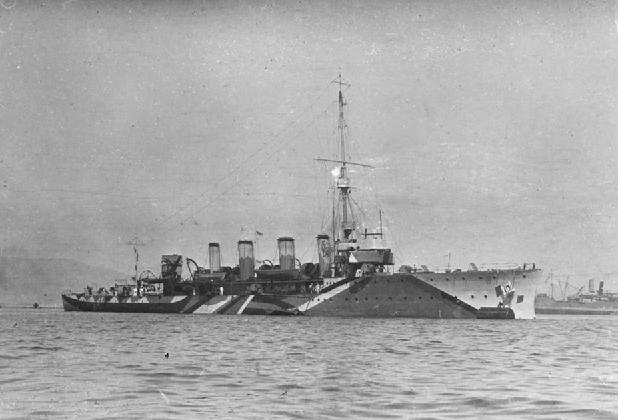
HMS Adventure in dazzle camouflage, 1918
The two Adventure class cruisers, HMS Adventure and Attentive, were the last in a series of 8 experimental “scouts” imagined by Sir John Fisher, an apostle of speed. They had a dual role: Lead the destroyers flotillas, and protect them in the event of a setback under cover of their powerful artillery, while providing eyes of the fleet at sea. They were vanguard reconnaissance elements, forward and on the wings of an advancing battle line.
They had no way of fighting against most of the enemy ships encountered, the only solution being speed and flight. They also had the range of action necessary for these missions. On this basis, very precise specifications were sent by the admiralty to various arsenals: 4 answered and were each entrusted with two vessels, a sufficient figure because it represented the leading potential of eight flotillas. Armstrong Elswick took care of the last two. First classified in the “3rd class”, then “light cruisers” in 1914, they had a hull with a continuous rear deck, unlike the two Forward class ships, which featured a quarterdeck. The two Sentinels had a turtleback forecastle deck to face heavy weather, unlike Pathfinder and Adventure, which had just raised bows.
They were laid down in January 1904 then launched in August-Nov. 1904 and accepted into service in October 1905. In service, they were widely criticized for their too light construction and especially their paltry armament: In 1914, most destroyers had 102 mm guns. The career of these ships was without notable incidents:
HMS Adventure collided with a sailing ship on the Sussex coast in April 1905, causing the latter to sink. She held the position of leader, 1st destroyer flotilla at Chatham in 1907, then the 2nd at Devonport in 1911. She joined the 3rd light cruiser squadron for maneuvers in 1913, and was assigned in 1914 to the 6th destroyer squadron at Dover. She was then sent in 1915 to the 6th Light Cruiser Squadron on the Humber, then was based until 1917 at Queenstown. She carried out a rescue (sinking of SS Huron), then escorted convoys to Gibraltar. She operated in this role until November then moved definitively to the Mediterranean and the Aegean in 1919. In 1920 it was sold for BU.
HMS Attentive experienced two collisions at the start of its active life: With the destroyer Quail in 1907 then the Gala and Ribble in 1908. After being put at the head of two squadrons of destroyers, it was sent to Ireland, then returned to sea of the North where he was part of the Dover flotilla. He fought against German destroyers and participated in the Zeebrugge Raid in 1918. He was sent to escort convoys to Gibraltar then passed to the Mediterranean, and in 1919, left to support the White Russians in the Black Sea. It was delisted and demolished in 1920.
HMS Foresight served at Portsmouth, Chatham and Dover, suffered a collision with the destroyer Falcon, then fought in 1914-1915 off Flanders. In 1916 he was sent to the Mediterranean. He saved the passengers of the hospital ship Britannic in November after serving in the Aegean Sea. She then returned to Chahtham, carrying out several sorties until retirement in 1919.
HMS Forward was assigned to several light squadrons successively at Portsmouth and Chatham, and in 1914 patrolled the Shetland Islands at the head of the 9th squadron of destroyers. He was in sight of the squadron of German battlecruisers which bombarded Hartlepool but made no attempt. He was then assigned to the Humber with the 6th Light Squadron then was sent to the Mediterranean in early 1916, and from May until 1919, operated in the Aegean Sea. She will be decommissioned on her return to Sheerness.
HMS Pathfinder was assigned to the Atlantic, then to the Channel and finally to the Home Fleet in the Orkneys. She was then posted to Chatham, placed in reserve, reassigned to the 4th Destroyer Squadron at Portsmouth, then replaced Amethyst in the 9th Light Squadron. In 1914 she patrolled the Irish coast. She was then assigned to Scapa Flow, and torpedoed on September 5, 1914 off St Abbs by U21.
HMS Patrol served in the Home Fleet, at Portsmouth then Chatham, and finally Haulbowline on the eve of the war, then replaced HMS Juno at the head of the 9th destroyer flotilla on the Tyne. She was in contact during the German raid on Scarborough in December. She was posted to the Humber, then in 1918 went to the Irish Sea, and at the end of the war to the Firth of Forth and was decommissioned in 1919.
HMS Sentinel was part of the 3rd Cruiser Squadron in the Mediterranean, then was assigned to the English Channel at Devonport, as leader of the 5th Destroyer Squadron. In 1913, after a short overhaul, he took part in the 3rd Light Squadron of the Home Fleet, then as Leader of the 9th Destroyer Squadron at Portsmouth, then to Dover, before taking command of the 8th squadron on the Forth. She then served in the Aegean Sea in 1918 after having served in the Mediterranean since 1915. At the end of 1918 she passed the Dardanelles and entered the Black Sea, supporting the White Russians until 1919. She was then posted to Chatham as an engineer training ship until 1922.
HMS Skirmisher served at Portsmouth, Devonport and Dover with the Home Fleet. She was posted temporarily with the 3rd Light Squadron on the Humber at Immingham, then returned to the Mediterranean. In November 1918 he was part of the Aegean squadron. He returned to Immingham before being discharged in 1919.
Specs:
Displacement & Dimensions: 2,500t, 2,640 T FL, 120.4 x 11.66 x 3.73 m
Propulsion: 2 shafts, 2x 3-cylinder TE , 12 Yarrow boilers, 16,000 hp. 25 knots
Armor: CT 76 mm, decks 51 mm.
Armament: 10 76 mm guns, 8 47 mm guns, 2 457 mm TLT (flanks) SM.
Crew: 268
 Boadicea/Blonde class (1908)
Boadicea/Blonde class (1908)
Boadicea, Bellona, Blonde, Blanche
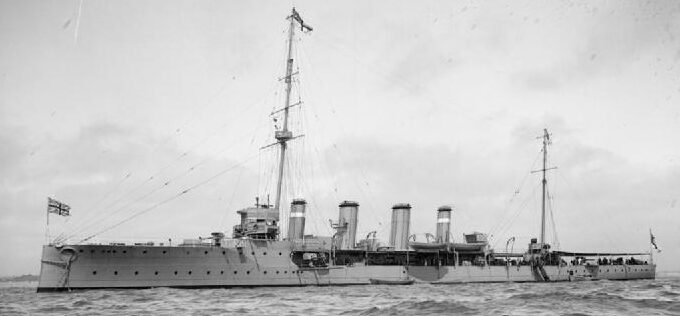
Three series of new scout cruisers intended to lead destroyer flotillas were designed in 1906. The first were the two ships of the Boadicea group (also including HMS Bellona). Built at Pembroke, like the subsequent HMS Blonde and HMS Blanche, they were fast but modestly armed, and a little too small for the Atlantic. On the other hand, they were appreciated at their true value in the North Sea. They were quickly surpassed, however, by the performance of the new destroyers running on oil and traveling at 29 knots, while having only a symbolic protection, made of a forward conning tower and some light deck armor as well as internal armor above the engine room. Launched in 1908-09, they were completed in 1909-10 and assigned to the 1st and 2nd Southern flotillas. the two ships were distinguished by their masts, that of the Bellona being larger at the rear, a configuration not included for reasons of stability.
They were rearmed in 1916 to have ten 4-in or 102 mm and one 3-in or 76 mm AA. In 1916, they were detached from their respective flotillas and placed within the Grand Fleet. They took part in the Battle of Jutland. HMS Boadicea was converted to a minelayer in 1917, laying 306 ore mines in the Denmark Strait over four voyages. In 1919, she was placed in reserve and sold for demolition in 1926. Bellona met an identical fate and was sold in 1921.
Technical Specifications
Displacement & Dimensions: 3,300t – 3,800t FL, 123.4 x 12.5 x 4.3 m
Propulsion: 4 shafts Parsons turbines, 12 Yarrow boilers, 18,000 hp. 25 knots.
Armor: Decks 25, CT 100 mm.
Armament (original): 6x 152 mm guns, 4x 47 mm guns, 2x 533 mm TTs deck.
Crew: 317
 Active class (1911)
Active class (1911)
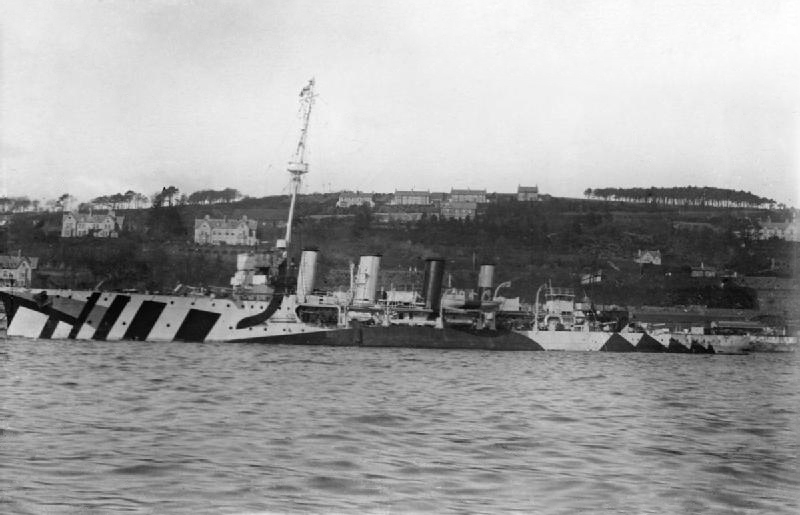
This class of three vessels derived closely from the preceding Blonde/Boadicea. This third group was to include only HMS Amphion and Active, but HMS Fearless was added a few months later. These three units were operational in 1913. Apart from some protection improvements, the main difference observable compared to the Blonde and Boadicea was an arched bow of a new “breakwater” model. A 3-in or 76 mm AA gun was added to them during the war.
HMS Active was in service with the 2nd Destroyer Squadron, transferred to Harwich. Then, after a stint in the Grand Fleet, she joined the 4th Fleet Division in Portsmouth and after 1917 in Queenstown, then in the Mediterranean. She was withdrawn from service in 1920.
HMS Amphion was assigned to the 3rd Fleet Division at Harwich, and blew up on August 6, 1914 on one of the mines of the German auxiliary cruiser Königin Luise, becoming the first naval loss of the war.
HMS Fearless served with the 1st Fleet Division at Harwich before becoming leader of the 12th Submersible Squadron, then finally as leader of the “K” class destroyers. She was involved in the Battle of the Isle of May on 31 January 1918, ramming K17, and was withdrawn from service in 1921.
Technical Specifications
Displacement & Dimensions: 3440t – 4000 t.PC, 123.8 x 12.6 x 4.7 m
Propulsion: 4 shafts Parsons turbines, 12 Yarrow boilers, 18,000 hp. and 25 knots max.
Armor: CT 100 mm, decks 25 mm.
Armament: 10 x 4-in/102 mm, 4 x 6-pdr/47 mm, 2 x 457 mm/18-in TTs.
Crew: 325
 Bristol class cruisers (1909)
Bristol class cruisers (1909)
Bristol, Gloucester, Glasgow, Liverpool, Newcastle
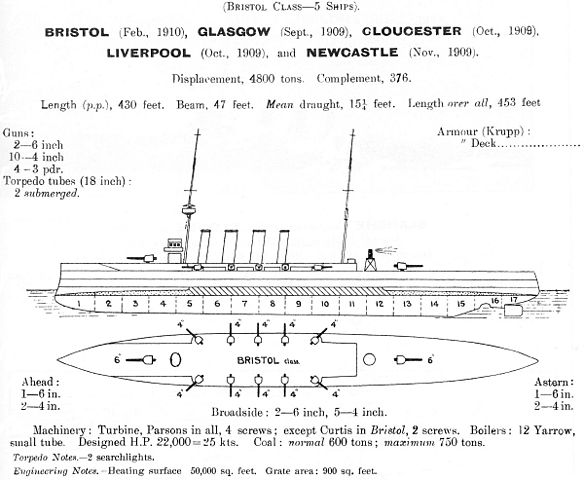
Alongside armoured cruisers, no medium cruiser since the 2nd class Gems in 1900 had seen the light of day when the new century started, notably due to the obstinacy of Lord Fisher who wanted to entrust this role to “super-destroyers”, like his pet project HMS Swift. But faced with the threat represented by their new generation German cruisers, it was time for the Admiralty to define, despite the advice of Lord Fisher, a new type of medium cruiser. Two 6-in or 152 mm cannons supplemented by QF guns intended against destroyers seemed a good compromise, as did their tactical designs halfway between scouting and fleet support.
These were in fact the first cruisers of the massive “Town class“, totaling 19 ships including the Weymouth, Chatham, and Birmingham classes. Criticized for their high metacentric height, cramped, prone to rolling and sometimes poor firing platforms, they were however satisfactory in service and gave rise to many improvements on subsequent classes. The Bristol class (laid down in 1909 and completed in 1910) included in addition to the Bristol, the Gloucester, Glasgow, Liverpool and Newcastle.
They were very active during the Great War, sent to distant stations:
HMS Bristol operated in the East Indies, with Admiral Stoddart’s Far East squadron, fighting the SMS Karlsruhe, then joined the Falklands squadron, fighting Von Spee in December, capturing German coal carriers, then driving out the SMS Dresden. She then served in the Mediterranean, then operated again in the South Atlantic until her decommission in 1921.
HMS Glasgow captured the German liner Catherina in 1914, and narrowly escaped destruction with the auxiliary cruiser Otranto during the Battle of Coronel won by Von Spee’s squadron. She took part in the English revenge on December 8th, sinking SMS Leipzig. She participated in the hunt for Dresden which succeeding in cornering and sinking her on March 14, 1915 off Juan Fernandez Island. She then participated in the hunt for the gunboat Möwe in the Mediterranean. She was based in the Adriatic, then in Gibraltar and joined the Grand Fleet at Scapa in 1918, before being sold in 1921, like the other ships of this class.
HMS Gloucester was based in the Mediterranean in 1913 and participated in the hunt for Souchon’s squadron, made up of Goeben and Breslau. She then participated in the hunt for Emden in the Pacific and the Indian Ocean and returned to the Mediterranean in 1914. She was assigned to the Grand Fleet, then detached to go to the coasts of West Africa for hunting German auxiliary cruiser Kronprinz Wilhelm. She captured the Macedonia, bombarded the Galway base, and served until the armistice in the Adriatic.
HMS Liverpool was part of the Grand Fleet in 1914 and fought at Heligoland, damaged by the explosion of HMS Audacious on 27 October 1914. She was then sent to track down the Crown Prince Wilhelm, then served successively from Brindisi in the central Mediterranean, was detached in the Aegean Sea, in the Dardanelles, then in the Black Sea in 1919 to support the White Russian fleet.
HMS Newcastle was sent on commissioning to replace the old HMS Bedford in China. She shelled insurgents in Shanghai in 1913, then was sent to South America to track down the privateer Prinz Eitel Friedrich, in the Pacific by capturing Mazatlan, in the Mediterranean (Mudros), then in the Adriatic, before ending her career in the Falklands.
Technical Specifications
Displacement & Dimensions: 3,300t – 3,800t FL, 123.4 x 12.5 x 4.3 m
Propulsion: 4 shafts Parsons turbines, 12 Yarrow boilers, 18,000 hp, 25 knots
Armor: Decks 25mm, CT 100 mm.
Armament (original): 6x 6-in/152 mm guns, 4x 6pdr/47 mm guns, 2x 533 mm TTs.
Crew: 317
 Weymouth class (1910)
Weymouth class (1910)
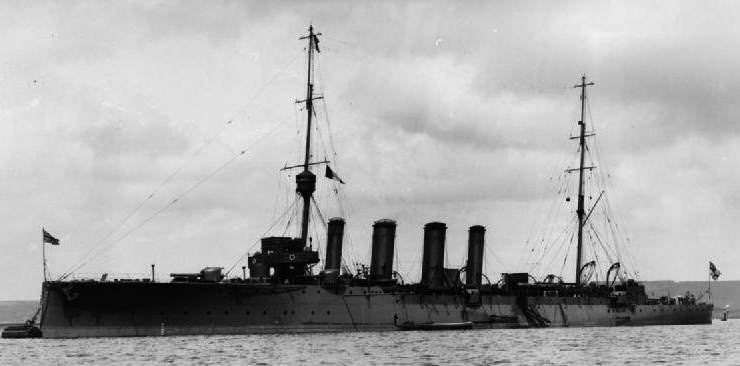
The four Weymouth-class cruisers were very similar to the five previous Bristols, except for their significantly enlarged hulls, giving them a greater tonnage by an extra 420 tons. Their hull was also modified to accommodate armament composed and distributed differently. In many respects, these were “improved Bristols”, with simplified armament, upgraded to a set of 6-in/152mm cannons requiring increased width to resolve the resulting stability problem. They had four guns forward on the forecastle, more effective in heavy weather. In 1915, a 3-in/75 mm AA gun was added on a platform between funnels. Masts at this time were reduced, and tripods added in 1917 to support a gun station forward, additional searchlights aft. An aircraft platform was added on Yarmouth and Weymouth in 1918. In the end, these four ships were considered very successful, served extensively during the war, and provided the basis for the later developments, the excellent Chatham and Birmingham classes completed during wartime.
HMS Dartmouth was operating from Bombay in 1914, she captured a German tug, then was assigned to the 2nd Light Cruiser Squadron (ECL) of the Grand Fleet, but remained in South America in search of the Karlsruhe. Later, she returned to India, then joined the Dardanelles, and remained until 1919 with the 8th ECL based in Brindisi. She was torpedoed in 1917 by UC25 which claimed victory, but against all odds, she managed to reach a port for repairs. She served until 1929.
HMS Falmouth joined the 5th EC with the Home Fleet in August 1914, sinking four German cargo ships in less than a month. She then moved to the 1st ECL as standard bearer, then the 3rd ECL, fighting in Jutland, suffering a shell hit. On August 19, 1916 she was torpedoed by U 66. Surviving its flooding, dead in the war, she had to be towed to a safe port, but en route was torpedoed again by U 52 and this time sank, but hours later, showing the excellence of their underwater protection.
HMS Weymouth sailed from the Atlantic to the Mediterranean, then to the Indian Ocean. At the start of the war, she embarked in the hunt for Emden, then later reached the west coast of Africa and the Rufiji delta to attack Königsberg. She then crossed the Mediterranean, the Adriatic, then returned to home waters and reached Bermuda. From 1917 she was assigned to the 8th ECL in Brindisi and was torpedoed by the Austrian U28 off Durazzo. Repaired in Malta, she remained there until 1919, and then served until 1928.
HMS Yarmouth served in the Mediterranean and China stations and at the start of the war she was sent to hunt down Emden. She captured the Pontoporos, ex-capture of the German cruiser, and sank also her assigned supply ship Markomannia. She was then assigned to the Grand Fleet, within the 2nd and 3rd ECL, fighting at Jutland. In June 1916 she was torpedoed by a U-boat without success, before joining the South Africa Station and the 2nd ECL in 1919, then she was assigned to South America. She want back to home waters as a training ship and troop transport until decommissioned in 1929.
Technical Specifications
Displacement & Dimensions: 5,250 t, 5,800 T FL, 138.1 x 14.6 x 4.7 m
Propulsion: 4 shafts Parsons Compound turbines, 18 Yarrow boilers, 24,000 hp. 25 knots
Armour: CT 100mm, decks 50 mm.
Armament: 8x 6-in/152mm guns, 4x 6-pdr/47mm guns, 2x 21-in/533mm TLTs sub bd.
Crew: 475
Wartime Cruisers
 Chatham class (1913)
Chatham class (1913)
HMS Chatham, HMS Dublin, Southampton +HMAS Melbourne, Brisbane, Sydney
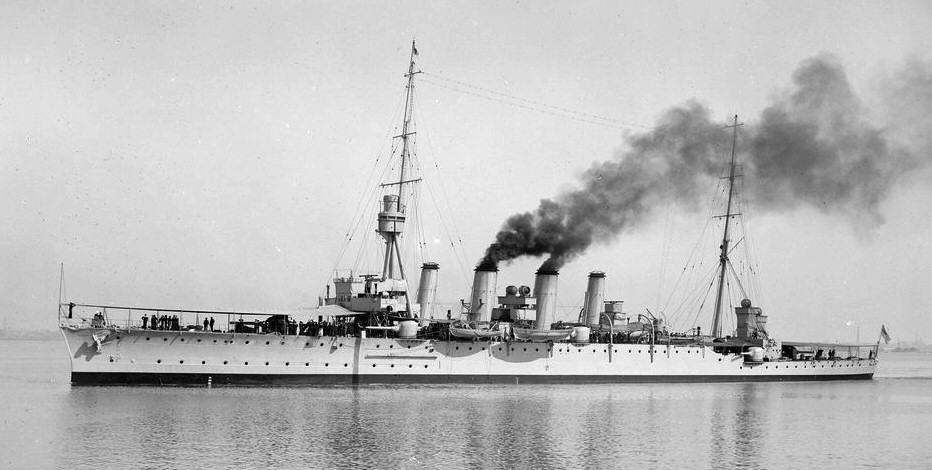
These six light protected cruisers were ordered through a split between the Royal Navy and Australian Navy, one to be built in an Australia yard for the first time. Under the 1910–1911 Programme through five British Yards they were completed in 1912-1913, with HMAS Brisbane laid down in 1913, completed in 1916. Amour scheme was improved, with a deep armoured deck over the machinery and magazines, additional vertical belt above high-tensile steel also taking part in the hull structure. The forecastle was extended to add more guns as they were longer than previous cruisers at 458 feet (139.6 m) and larger at 49 feet (14.9 m) for 5,400 long tons (5,500 t) normal, 6,000 long tons (6,100 t) fully loaded. More seaworthy, they were stable gun platforms. Only issue was their traditional Officer’s accommodation aft, far from the bridge, not ideal for quick reaction from the staff.

HMS Southampton, tested a two-shaft layout rather than four-shaft, for 25,000 horsepower and 25.5 knots. Armament was uniform between eight 6-in guns BL Mk XII and received later one 3-inch AA gun in 1915, and tripod mast with director control. After HMS Yarmouth, HMS Dublin, Southampton, as well as HMAS Melbourne and Sydney were given the same type of platforms to operate aircrafts.
 Birmingham class (1914)
Birmingham class (1914)
HMS Birmingham, Nottingham, Lowestoft
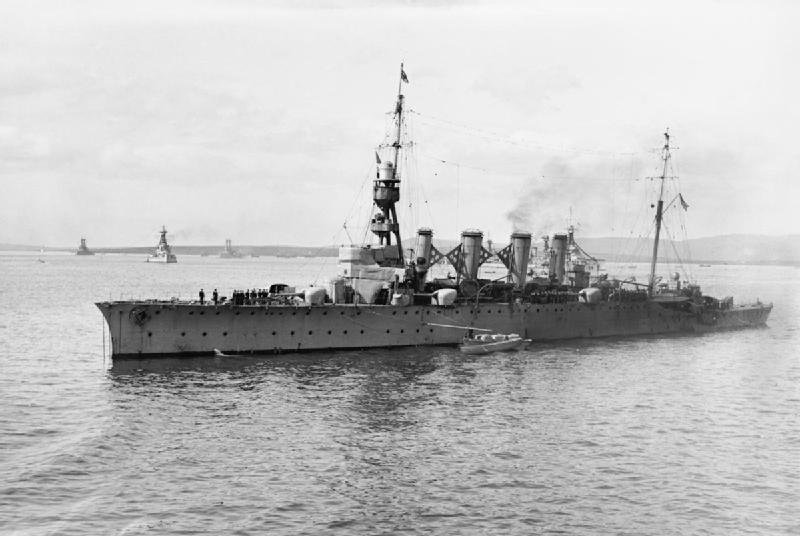
The success of the Chatham class cruisers led the Admiralty to order three more, HMS Birmingham, Nottingham and Lowestoft. They were started in 1912, launched in 1913 and completed in early 1914. They were virtually copies of the first, except that they had an additional 6-in/152 mm cannon forward with an arrangement of two side guns. HMS Lowestoft was equipped with a tripod mast from the beginning, supporting a searchlight platform, a configuration applied during a redesign of HMS Birmingham in 1917. Their platform was enlarged to support a 3-in/76mm AA gun added in 1915.
These ships were followed by the construction of a fourth one, HMS Adelaide, started at Cockatoo shipyard in Australia for the RAN. The latter, launched in 1918 and completed in 1922, incorporated all the modifications of the former.
HMS Bimingham sank two German cargo ships in 1914, and rammed and sank U15 a few days after the start of hostilities. She took part in the Battle of Dogger Bank and the Battle of Jutland, only slightly damaged there. She was placed in reserve in 1920 then returned to service in distant stations before being retired in 1931.
HMS Lowestoft served in the North Sea, sinking a German cargo in 1914, participating in the Dogger Bank action, then joining the Mediterranean squadron where she remained until 1919. She was based in Africa until 1924, then other distant stations, and sold in 1931.
HMS Nottingham fought at the Dogger bank and Jutland, and was sunk on August 19 1916 by U52, after being hit by three torpedoes, and carrying 38 crewmen.
HMAS Adelaide took part in the Second World War but she will have a dedicated post.
Technical Specifications
Displacement & Dimensions: 5,440t – 6,040t FL; 139.3 x 15.2 x 4.9 m
Propulsion: 4 shafts Parsons turbines, 12 Yarrow boilers, 25,000 hp. 25.5 knots.
Armor: Belt 50, decks 40-15, CT 102 mm.
Armament: 9 x 6-in/152 mm, 4 x 6-pdr/47 mm, 2 x 21-in/533 mm sub.
Crew: 480
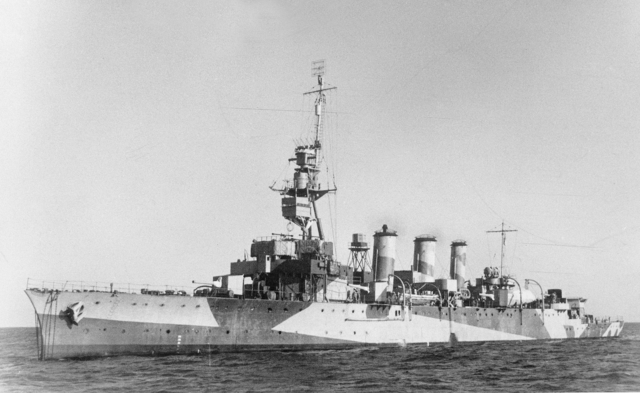
HMAS “longdelayed” (Adelaide), completed in 1922 but of a modified 1912 design. Here in 1942.
 Birkenhead class (1914)
Birkenhead class (1914)
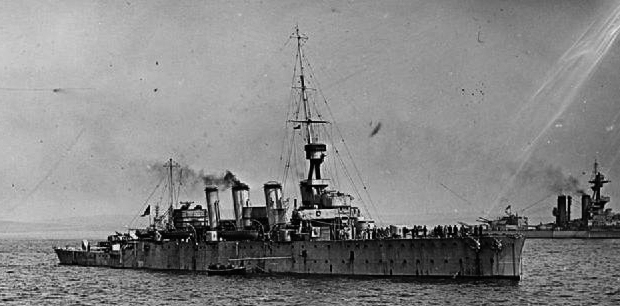
The Greek Navy threatened by the Turkish naval expansion after the Balkan war in 1912, placed an order to the Coventry Syndicate (Cammell Laird, Fairfields, John Brown plus the Coventry Ordnance Works) for two light cruisers and four destroyers. The light cruisers were built at Cammell Laird, as Antinavarchos Kountouriotis and Lambros Katsonis, same design as before, with Coventry Ordnance of ten QF 5.5 in/50 (140 mm) Mark I guns. They were seized while in construction in 1915 the British Admiralty, and became the Birkenhead class. They received 5.5 in guns and Vickers 3-pdr guns and proposed to the Greeks, postwar but declined, then sold for BU in 1921.
 Arethusa class cruisers (1913)
Arethusa class cruisers (1913)
HMS Arethusa, Aurora, Galatea, Inconstant, Penelope, Phaeton, Royalist, Undaunted.

The Arethusa-class cruisers were flotilla leaders for destroyer, providing a backup against enemy destroyers. They were in the straight line of previouss scouts, and a “prequel” to the famous large “C class”. They were powered by four Brown-Curtis steam turbines/Yarrow boilers for 40,000 shaft horsepower and 28.5 knots and 3,200 nautical miles (5,900 km; 3,700 mi) of range at 16 knots.
Main armament comprised two BL 6-inch (152 mm) Mk XII guns, centreline fore/aft plus six QF 4-inch (102 mm) Mk V guns amidships and as now a standard, a single QF 3-pounder 47 mm (1.9 in) anti-aircraft gun. There were also two twin 21-inch (533 mm) torpedo tubes on deck, and this was going to increase.
Built 1912–1915 and in commission 1914–1924, they took an active part in WWI operations, participating in famous battles.
Arethusa (Chatham Dockyard) was sunk by mine off Felixstowe on 11 February 1916.
Aurora (Devonport Dockyard) took part in the sinking of the German raider Meteor on 9 August 1915 and was transferred to the RCN by November 1920, sold for BU 1927.
Galatea (William Beardmore) also sank the Meteor and after no more outstanding records, was BU in 25 October 1921.
Inconstant (Beardmore) comp. January 1915. Had not particular note. Sold for BU 9 June 1922.
Penelope (Vickers, Barrow) damaged by a torpedo from UB-29 on 25 April 1916, but survived, repaired, sold 1924.
Phaeton (Vickers) comp. February 1915, fought at the Dardanelles. Sold 1923.
Royalist (Beardmore) comp. March 1915. No notable event. Sold 1922.
Undaunted (Fairfield) took part in the Battle off Texel 17 October 1914. Sold 1923.
Galatea, Inconstant, Phaeton and Royalist all took part in the battle of Jutland.
C class Cruisers
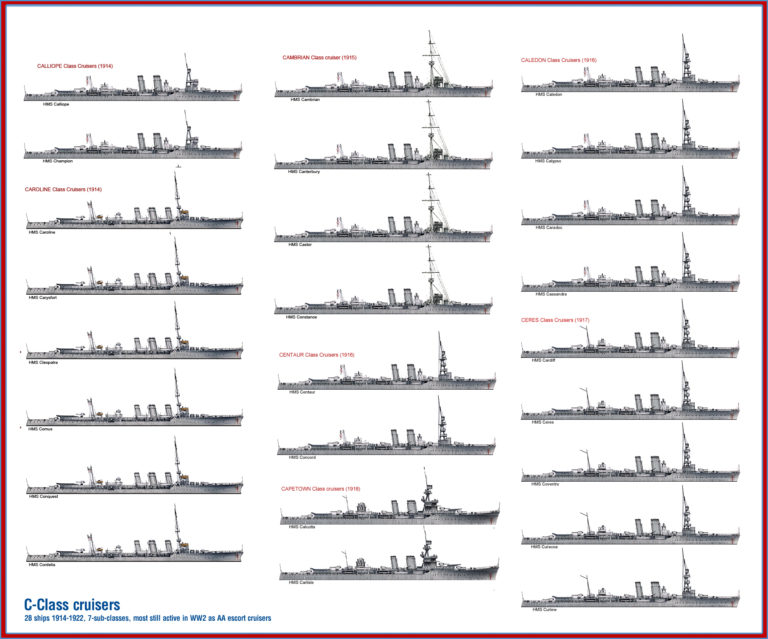
The Scouts were classed by letters, names being chosen in accordance. The Active/Adventure class sent a pattern. The letter “C” led to a large number of cruisers, and constituted a “superclass”, some authors are making of it a single class, albeit they differed between them despite obvious similarities in design. This really became the bedrock of the Royal Navy cruiser force during the war, the first entering service in late 1914 and the last postwar. Although the hull kept the same design and dimensions for most of their construction, there were still 7 sub-classes within these 28 ships. They were also still there during the interwar, and most were still active in WW2, mostly as escort and AA vessels. The “D” or Danae class were the unique vessels for this letter, before the “E” class or Emerald, which plan was curtailed by the end of the war. The “world’s first heavy cruisers” (at least in a modern sense because the Kaiserliches Marines named as such its armoured cruisers) were named after famous Elisabethan corsairs and privateers and a brand new experiment. The alphabetic class naming for cruisers was abandoned in the interwar but applied to destroyers (again).
 Caroline class (1914)
Caroline class (1914)
HMS Caroline, Carysford, Cleopatra, Comus, Conquest, Cordelia

The first C class generally followed the Arethusa class design, with a 6-in gun forward and another aft but the two aft 6-in guns were in superfiring position. They were considered as a gradual improvement and just at first an extra six ships for the admiralty’s “Light armoured cruiser” 1913 program with slight differences. They were 10 feets longer with a bit more beam for improved stability and four 6-in guns in all, eight 4-in guns on broadsides and forward deck or forecastle, single 13 Pdr AA and four versatile/saluting 47 mm guns. Single mainmast forward and three funnels, all raked. Four shafts and Parsons turbines, eight Yarrow boilers for 30,000 hp and 28-1/2 knots on trials. Completed from December 1915 to June 1915 they took in important part to the wartime operations and saw battles. HMS Caroline is the only survivor of that era, one of the very rare preserved WWI cruisers today.
Wartime changes comprised the removal of the 4-inch (102 mm) guns in Caroline, Carysfort and Comus for more 6-inch guns. Cleopatra, Conquest and Cordelia kept two 4-inch guns, and two 2-pounder guns added.
Caroline (Cammell Laird) became a drill ship for the Volunteer Reserve in April 1924, stayed at Alexandra Dock, Belfast until 31 March 2011, officially decommissioned and converted to a museum.
Carysfort (Pembroke) was sold for BU in August 1931.
Cleopatra (Devonport) was sold for BU June 1931.
Comus (Swan Hunter/Wigham Richardson, Wallsend on Tyne) comp. January 1915, was sold July 1934.
Conquest (Chatham) completed June 1914, was sold for BU August 1930.
Cordelia (Pembroke) completed June 1914, was sold in July 1923.
 Calliope class (1914)
Calliope class (1914)
HMS Calliope, Champion
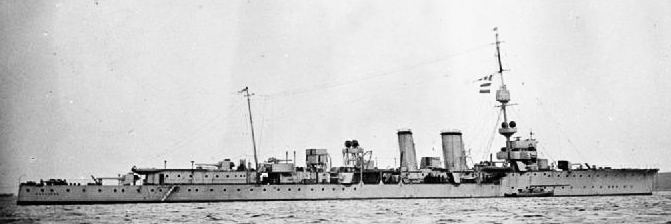
Last pair of the eight “light armoured cruisers” ordered July-August 1914 (1913 Programme), first ever fitted with geared steam turbines, on 2 or 4 props, with increased belt armour. They were commissioned mid-late 1915 with a more efficient boiler layout, for two funnels, a silhouette that became standard for the C-class. They had different machinery types for comparisons, and for armament, swapped to underwater tubes, later removed.
Calliope: (Chatham) completed June 1915, sold 28 August 1931.
Champion: (R. & W. Hawthorn Leslie) completed December 1915, sold 28 July 1934.
 Cambrian class (1915)
Cambrian class (1915)
Cambrian, Canterbury, Castor, Constance
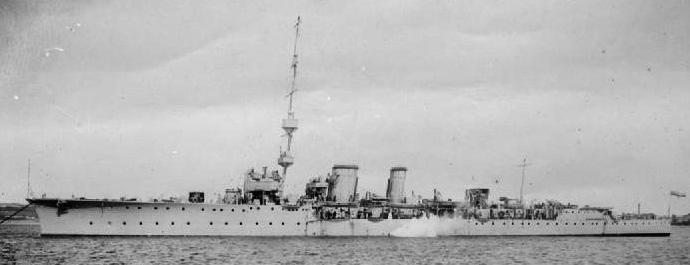
These were the firsts of the new wartime 1914-15 Programme in September. They were commissioned 1915-1916 and kept two funnels with a machinery based on the Calliope subclass, similar armament, four 6-inch (152 mm) guns, eight 4-inch (102 mm) guns. Canterbury and Champion only kept a single of the latter and after removal, 2-3 3-inch (76 mm) AA guns were added. Deck TTs as well.
Specifications:
Dimensions: 135.90 m long, 12.6 m wide, 4.5 m draught. (446 x 41 x 14 ft)
Displacement: 4,320 tons standard; 4,799 tons Fully Loaded
Crew: 368
Propulsion: 4 shaft Parsons (Canterbury Brown Curtis) turbines, 6 Yarrow boilers, 40,000 hp.
Speed: 28.5 knots.
Range: 6000 nm @ 10 knots. 841 tons oil
Armament: 2 x 6in/45 XIII (152 mm), 8 x 4in/45 (102 mm) QF Mark IV, 8 x 3pdr DP (47 mm), 1 x 13 pdr, 2 x 21-in TTs.
Protection: Belt 40-75 mm, decks 25 mm, Masks 25 mm (1 in), CT 152 mm (6 in)
Cambrian (Pembroke): Completed May 1916, sold for BU 28 July 1934.
Canterbury (John Brown): Completed May 1916, sold 28 July 1934.
Castor (Cammell Laird): completed November 1916, sold 30 July 1936.
Constance (Cammell Laird) completed January 1916; sold 8 June 1936.
 Centaur class (1916)
Centaur class (1916)
Centaur, Concord
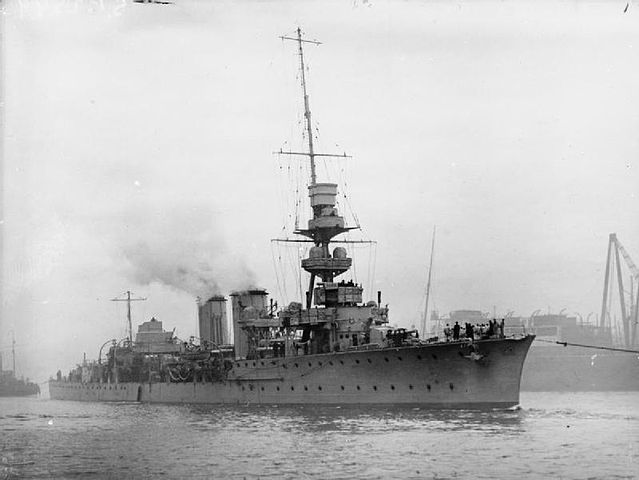
A sub-class ordered in December 1914, built with the materials for the ships ordered by Turkey initially. Both commissioned in 1916 had geared turbines, four screws, two funnels but five 6 in guns in single mounts and still 4-inch (102 mm) guns later replaced by smaller and/or AA guns. During their 1918 refit they also received a tripod for a large spotting top.
Centaur (Armstrong-Whitworth): completed in August 1916, sold for BU February 1934.
Concord (Armstrong-Whitworth): completed December 1916, sold for BU August 1935.
 Caledon class (1916)
Caledon class (1916)
Caledon, Calypso, Cassandra, Caradoc

The Caledon class were ordered in December 1915, still two funnels plus propulsion slightly different and superstructure altered. Same main armament, five 6-inch guns but two 3 in guns, and four 3-pdr guns. Some in the class suvived to see World War II and had a lot of modifications notably with Oerlikon 20 mm cannons, or Caledon being rebuild as an AA cruiser with new twin 4-inch (102 mm) guns, two 40 mm Bofors and eight 20 mm Oerlikons.
Caledon (Cammell Laird): Completed March 1917. AA cruiser December 1943, sold 22 January 1948.
Calypso (Hawthorn Leslie): Completed June 1917, fought WW2, sunk by the Italian sub Bagnolini, Crete 12 June 1940.
Cassandra (Vickers): Completed June 1917, hit a mine in the Baltic 5 December 1918.
Caradoc (Scott’s Shipuilding and Engineering Co): Completed June 1917. Base ship April 1944, sold May 1946.
 Ceres class (1917)
Ceres class (1917)
Cardiff, Ceres, Coventry, Curacoa, Curlew
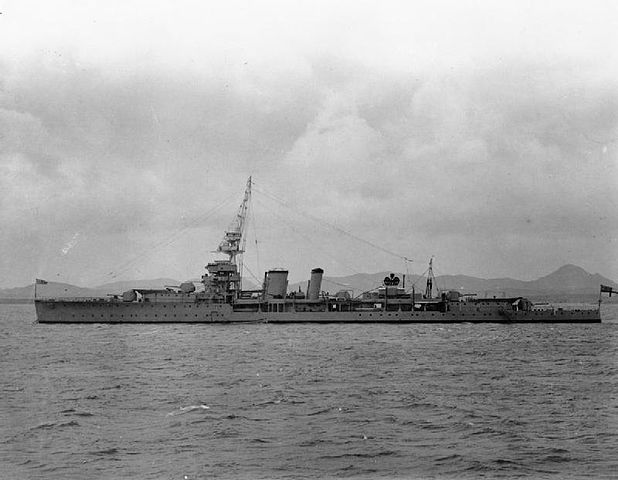
The Ceres class were ordered in March-April 1916, commissioned 1917-1918 and albeit faster, they were recoignised as very “wet” forward, so the next Carlisle sub-class received the famous “trawler bow” that became a trademark of next British cruisers. Otherwide, the main armament comprised five 6-inch (152 mm) axial guns, two 3-inch (76 mm) AA guns and three for HMS Ceres herself as well for all, Four 3-pounder guns. They all served in the interwar and were still around in WW2, being either converted as escort cruisers or rebuilt as AA cruisers.
Specifications:
Displacement 4,290 tons standard, 5,276 tons full load
Dimensions: 452 x 43.5 x 14 ft (138 x 13.3 x 4.3 m)
Propulsion: 2x shaft Brown-Curtis geared turbines, 6 boilers 40,000 shp, 29.5 knots, RA 5,900 nm
Armed with 5-6 BL 6-in Mk XII guns, 2x QF 3 in, 2×2-pdr, 2×4 21-in TTs
Protection: Machinery spaces: 3 in sides, magazines 2+1⁄4 inch sides, deck 1 inch
Cardiff (Fairfield) completed June 1917, sold 23 January 1946.
Ceres (John Brown) completed June 1917, sold 5 April 1946.
Coventry (Swan Hunter) completed February 1918. AA ship 1937, sunk aircraft off Tobruk 14 September 1942.
Curacoa (Pembroke) completed February 1918. AA ship 1939, sunk collision with RMS Queen Mary off Ireland 2 October 1942.
Curlew (Vickers) completed December 1917, AA ship 1938; sunk by aircraft Ofotfjord 26 May 1940.
 Carlisle/Capetown class (1918)
Carlisle/Capetown class (1918)
Calcutta, Capetown, carlisle, Colombo
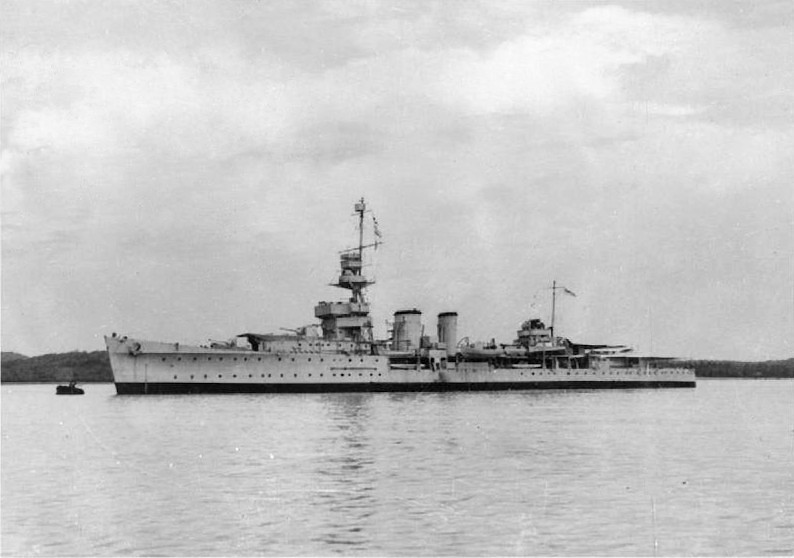
The Carlisle class were ordered in June-July 1917 (War Emergency Programme) but commissioned only for the first in 1918, the last delayed until 1922. First with the “trawler bow” raised it and no conning tower, considered an obsolete feature. Five 6-inch (152 mm) for main armament, two 3-in (76 mm) AA guns and four 3-pdr but also two 2-pdr guns, both dual purpose. First with four twin TT banks instead of two triple. They all survived the great war, served in the interwar and were active in WW2 as well. Some authors separate the Capetown as a sub class.
Specifications:
Displacement 4,200 tons standard; 5,300 tons full load
Dimensions 452 x 43.5 x 14 ft (138 x 13.3 x 4.3 m)
Propulsion: 2 shafts Parsons/Brown-Curtis geared turbines, 6 boilers 40,000 shp, 29.5 knots RA 5,900 nm
Crew 334
Armament: 5x BL 6-in Mk XII, 2x QF 3 in, 2x 2-pdr, 4×2 21-in TTs
Armour: Machinery spaces 3-in, Magazines 2+1⁄4-in, Deck 1-in
Calcutta (Vickers) completed August 1919. AA ship 1939, sunk air attack, evacuation of Crete 1 June 1941.
Capetown (Cammell Laird) completed Pembroke April 1922. Sold 5 April 1946.
Carlisle (Fairfield) completed November 1918. AA ship 1939, base ship 1944, sold Alexandria 1948.
Colombo (Fairfield) completed July 1919. AA ship 1943, sold 22 January 1948.
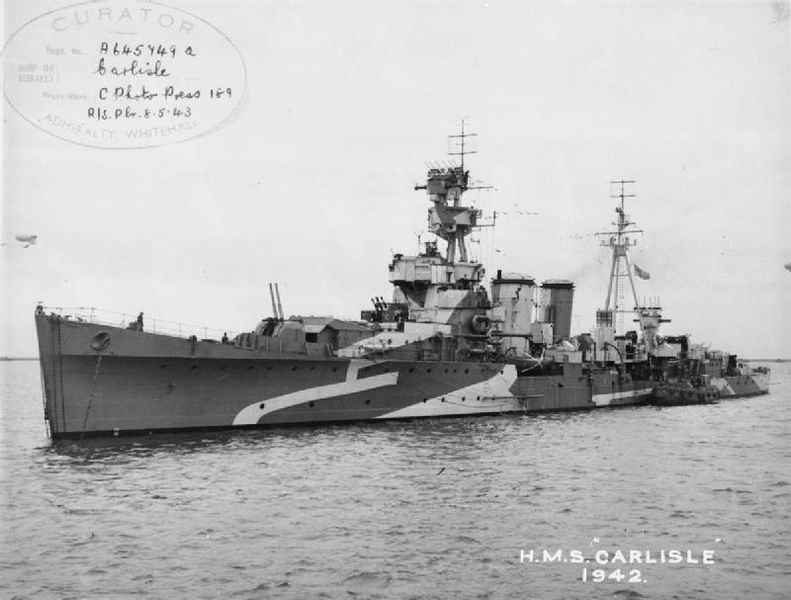
HMS Carlisle in 1942. Three of the class were rebuilt as AA cruisers and took part in WW2. The class paid a less heavy price to the war than the previous Ceres class
 Danae clas (1918)
Danae clas (1918)
Danae, Dauntless, Dragon, Delhi, Dunedin, Durban, Despatch, Diomede.
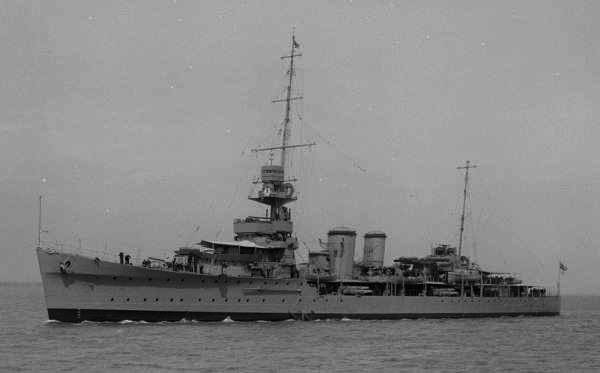
The Danae class were a bit more than just “improved Ceres”. Ordered by September 1916, these three ships had a lengthened hull and five guns to face possible new powerful German light cruisers. their beam was increased to accommodate triple torpedo tubes had 20% more ammunition storage and twice as much spare torpedoes. By July 1917, three more were ordered as part of the 2nd Group – Delhi, Dunedin and Durban and then six more in March 1918, but last four cancelled (Daedalus, Daring, Desperate, Dryad) in November. All modified like the Capetown class with trawler bows and tripod masts. Some were built with a seaplane hangar abaft “R” gun, later removed. HMS Diomede tested an enclosed gunhouse with high elevation as “anti-zeppelin” gun.
All served in the interwar and WW2. None was ready before the war ended.
Specifications:
Dimensions: 144 x 13.2/14* x 4.4/4.5* m (472 x 46-47* x 16.5 feets)
Displacement: 4,850 tons standard, 5,925 tons Fully Loaded
Crew: 450/469 wartime
Propulsion: 2 shafts Parsons turbines, 6 Yarrow boilers, 40,000 hp, 29 knots, RA 2300 nm/27 knots.
Armament: 6× 6-in/45, 2x 3-pdr/45, 2x 2-Pdr/39 AA, 4×3 21-in TTs
Protection: Belt 1.5-2.25 in, decks 1 in, Masks 25 1 in
Danae (Armstrong Whitworth) comp 18 Jul 1918, transferred to the Polish Navy as ORP Conrad 4 Oct 1944 – 28 Sep 1946, sold 22 Jan 1948
Dauntless (Palmers Shipbuilding) comp 2 Dec 1918, sold 13 Feb 1946
Dragon (Scotts) comp 16 Aug 1918 , transferred Polish Navy 15 Jan 1943 as Piorun, damaged German Neger 8 Jul 1944, BWt Normandy beaches 20 Jul 1944
Delhi (Armstrong Whitworth) comp 7 Jun 1919, sold 22 Jan 1948
Dunedin (Armstrong Whitworth) comp Oct 1919 Devonport, transferred RNZN 1925, torpedoed U-124 Saint Paul’s Rock, South Atlantic 24 Nov 1941
Durban (Scotts) comp 1 Sep 1921 Devonport, breakwater Normandy 9 Jun 1944
Despatch (Fairfield) comp. 2 Jun 1922 Chatham. Sold 5 Apr 1946
Diomede (Vickers) comp. 24 Feb 1922 Portsmouth, transferred RNZN 1925; sold 5 Apr 1946
Daedalus (Armstrong Whitworth): cancelled 26 Nov 1918
Daring (William Beardmore): cancelled 26 Nov 1918
Desperate (Hawthorn Leslie): cancelled 26 Nov 1918
Dryad (Vickers): cancelled 26 Nov 1918
 Cavendish class (1917)
Cavendish class (1917)
Hawkins, Raleigh, Frobisher, Effingham, Cavendish
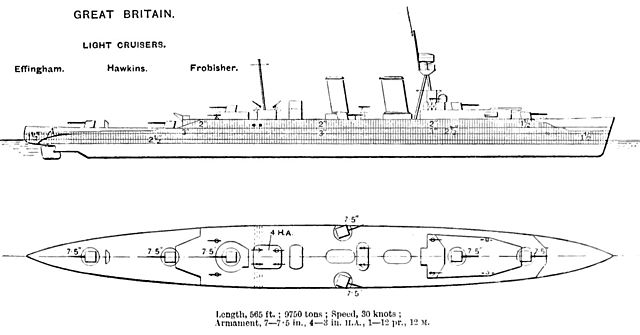
These were a very special breed of cruisers, dubbed by most authors the “first heavy cruisers”, for various reasons, notably the RN own classifications. They had been designed specifically during the war to hunt down new expected (intel error) fast German cruiser minelayers but also German commerce raiders abroad from far away overseas stations. Von Spee’s scharnhost class and most German armoored cruisers indeed and 170 to 210 mm main guns. Apart these seven single 7.5-in guns (190 mm), five axial, two broadside, they also had four 3-in AA and two 2-pdr, plus two submerged and four fixed surface 21-inch (533 mm) torpedo tubes. Thanks to their powerful machinery they were also the fastest of all British cruisers ever built to that point with 31 knots on trials.
Specifications:
Dimensions: 184oa x18 x5.26 m (605 x58 x17 ft)
Displacement: 9,750 tons Standard, 12,190 tons FL
Crew; 712-750 flagship
Propulsion: 4 shafts Parsons geared steam turbines, 10 Yarrow boilers, 70,000 hp, 31 knots RA 5400 nm
Armament: 7x 190mm, 3x 102 mm, 8x 76mm DP, 2 Bofors 40mm AA, 6 TT 533mm
Armor: Belt 38-64 mm (1.5-2.5 in), decks & bulkheads 38-51 mm (2 in).
Hawkins (HM Dockyard) comp. 19 July 1919, ww2 convoy escort Indian Ocean, gunfire support Normandy. BU Dalmuir, 1947
Raleigh (Beardmore) comp. July 1921, Ran aground Point Amour Forteau Bay Labrador 8 August 1922, BU 1926
Frobisher (HM Dockyard) comp 3 October 1924, convoy escort, depot ship Normandy, attacked E-boats, TS 1944-1945. BU Newport, 1949
Effingham (HM Dockyard) comp. 9 July 1925, Wrecked Faksen Shoal, Bodø, Norway, 18 May 1940 scuttled by HMS Echo
Cavendish (Harland & Wolff) comp. October 1918, converted aircraft carrier as Vindictive June 1917 (see later)

Effingham as rebuilt in 1938
 Emerald class (1919)
Emerald class (1919)
Enterprise, Emerald
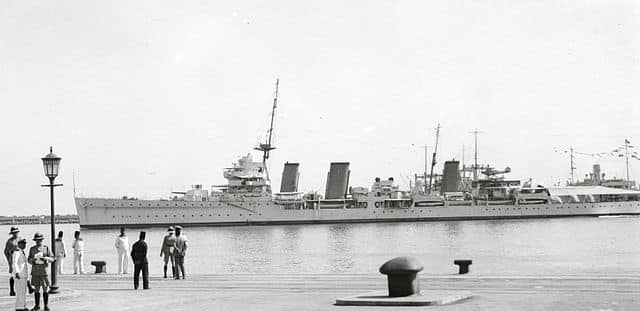
The two Enterprise (Enterprise and Emerald) or “E” class were the last British light cruisers built during the Great War. Laid down in 1918, they were only launched in 1920. They were completed, with much revisions however in 1926. Originally built to counter the German minelayer Brummer and Bremse of 1917. They became the fastest British cruisers as they could achieve 33 knots, using paired engines from the Shakespeare class flotilla leaders while still havinf the same D class main armament but displacement reached almost 10,000 tonnes fully loaded.
HMS Enterprise was completed with a twin turret, with BL 6 in (152 mm) L/50 Mk XXIII guns in mount Mk.XXI. A third ship, HMS Euphrates, was ordered to Fairfield Shipbuilding and Engineering Company, Govan in 1918 but Cancelled on 26 November 1918.

Specifications:
Dimensions: 173.7 x16.6 x6.6 m (570 x54 x16 ft)
Displacement: 8250 tons S, 10220 tons FL
Crew: 680
Propulsion: 4 screws, 4 BC turbines, 8 Yarrow boilers, 80,000 hp, 33 knots RA 8,000nm/15 kts
Armament: 7x 152mm, 5x 102mm MK VIII AA, 8 Bofors 40mm AA, 4×4 TT 533mm
Armor: Sides 38-76 mm (1.5-3 in), deck 25 mm (1 in).
HMS Emerald: Interwar service, escort missions, Norwegian campaign (hit Narvik), Force H Med, operation Catapult, Indian Ocean, Far East. Refitted to chase German raiders. Battles DD and TBs on December 1943. Escort until June 1944, battery cover. January 1945 reserve, troops repatriation, BU 1948.
HMS Enteprise: Radars/tripod masts 1940, North Atlantic British gold reserves, Indian Ocean, Mediterranean, Persian Gulf, Iraqi coast, Red Sea Force Z Singapore. Overhaul home 1942, 4th cruiser sqn Indian Ocean. D-Day landings, Gold Beach. Reserve, BU 1948.
 HMS Vindictive: The hybrid carrier cruiser (1918)
HMS Vindictive: The hybrid carrier cruiser (1918)
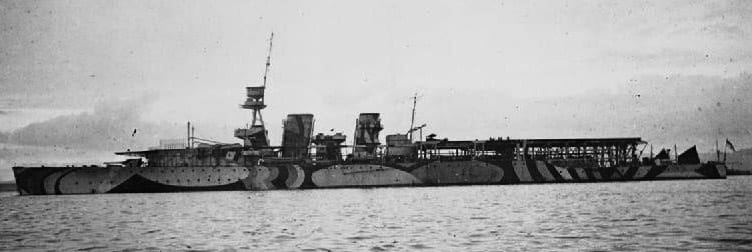
HMS Vindictive as completed as an hybrid aircraft carrier with a capacity for six reconnaissance aircraft. She was briefly armed with four 7.5 in guns and six 12-pounder guns but in 1923 was converted back as a cruiser, only retaining a forward hangar and instead of ‘B’ gun a crane and catapult were fitted. Fleet repair ship in 1940 she was damaged by an airborne “Dackel” torpedo off Normandy. Repaired she served as a destroyer depot ship (reserve 1945, BU 1946).
 1918 Cruiser Design A
1918 Cruiser Design A
After the “E” class, new erroneous reports from the intel accumulated on the admiralty’s desk, the most worrying one being on a new class of German destroyers armed with two 8.2-inches guns. The DNC (Director of Naval Construction) was thus asked to prepare new designs. To spare time as it was en emergency, these two proposals were no more than “repeat E” armed with the same 7.5-in guns as the Cavendish class. They could have been this the “F” class. Names are completely prospective such as Fox, Faulknor, Firedrake, Foresight, Forester, Fortune, Foxhound, Fury. These names were given to the E/F class destroyers of the interwar when the programme was cancelled.
⚙ A design specifications |
|
| Displacement | 7700t standard |
| Dimensions | 570ft x 54ft 6in x 15ft 3in (173.7 x 16.6 x 4.7m) |
| Propulsion | 4 shafts Brown-Curtiss geared steam turbines, 8 Yarrow Boilers, 80,000 shp |
| Speed | 33 kts |
| Range | Oil 1600t, same range as E class |
| Armament | Four 7.5-in MkVI, four 4-in AA, 4×2 21-in TTs |
| Protection | Same as E class: Belt 3 in, Deck 1-1/5 in |
| Crew | 450+ |
 1918 Cruiser Design B
1918 Cruiser Design B
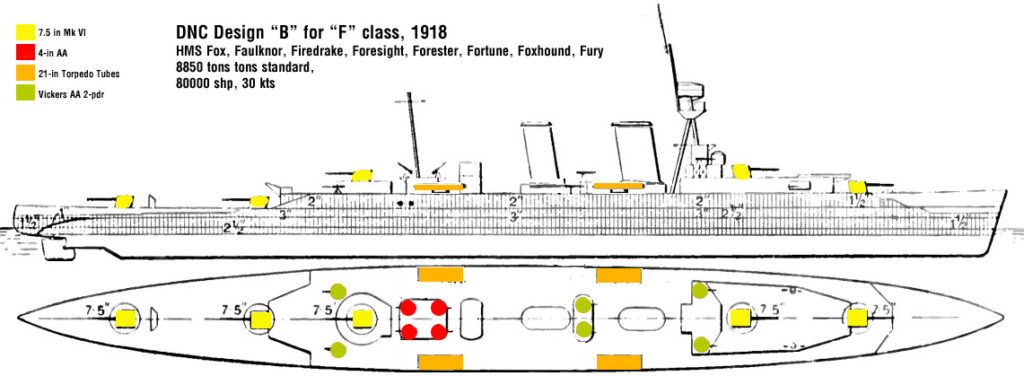
Design B was more of a repeat of the Cavendish class but with greater emphasis on range while keeping high speed. Their hull ratio was a bit more favourable to compensate for the added tonnage but they were slower, for the gain of a single extra main gun so it was probably a bit less tempting for costs reasons. (Author’s illustration based on Cavendish Brasseys graphic)
⚙ B design specifications |
|
| Displacement | 8,850 t standard |
| Dimensions | 607ft x 58ft x 15ft 9in (185 x 17.7 x 4.8m) |
| Propulsion | 4 shafts geared steam turbines, 8 Boilers, 80,000 shp |
| Speed | 30 kts |
| Range | Oil 1600t, same range as E class |
| Armament | Five 7.5-in MkVI, four 4-in AA, 4×2 21-in TTs |
| Protection | Same as E class: Belt 3 in, Deck 1-1/5 in |
| Crew | 460+ |

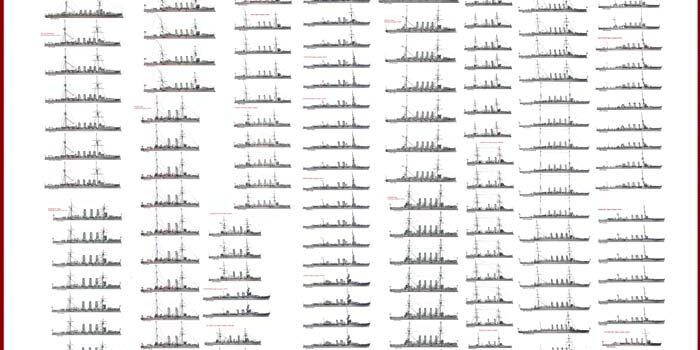

 Latest Facebook Entry -
Latest Facebook Entry -  X(Tweeter) Naval Encyclopedia's deck archive
X(Tweeter) Naval Encyclopedia's deck archive Instagram (@navalencyc)
Instagram (@navalencyc)





 French Navy
French Navy Royal Navy
Royal Navy Russian Navy
Russian Navy Armada Espanola
Armada Espanola Austrian Navy
Austrian Navy K.u.K. Kriegsmarine
K.u.K. Kriegsmarine Dansk Marine
Dansk Marine Nautiko Hellenon
Nautiko Hellenon Koninklije Marine 1870
Koninklije Marine 1870 Marinha do Brasil
Marinha do Brasil Osmanlı Donanması
Osmanlı Donanması Marina Do Peru
Marina Do Peru Marinha do Portugal
Marinha do Portugal Regia Marina 1870
Regia Marina 1870 Nihhon Kaigun 1870
Nihhon Kaigun 1870 Preußische Marine 1870
Preußische Marine 1870 Russkiy Flot 1870
Russkiy Flot 1870 Svenska marinen
Svenska marinen Søværnet
Søværnet Union Navy
Union Navy Confederate Navy
Confederate Navy Armada de Argentina
Armada de Argentina Imperial Chinese Navy
Imperial Chinese Navy Marinha do Portugal
Marinha do Portugal Mexico
Mexico Kaiserliche Marine
Kaiserliche Marine 1898 US Navy
1898 US Navy Sovietskiy Flot
Sovietskiy Flot Royal Canadian Navy
Royal Canadian Navy Royal Australian Navy
Royal Australian Navy RNZN Fleet
RNZN Fleet Chinese Navy 1937
Chinese Navy 1937 Kriegsmarine
Kriegsmarine Chilean Navy
Chilean Navy Danish Navy
Danish Navy Finnish Navy
Finnish Navy Hellenic Navy
Hellenic Navy Polish Navy
Polish Navy Romanian Navy
Romanian Navy Turkish Navy
Turkish Navy Royal Yugoslav Navy
Royal Yugoslav Navy Royal Thai Navy
Royal Thai Navy Minor Navies
Minor Navies Albania
Albania Austria
Austria Belgium
Belgium Columbia
Columbia Costa Rica
Costa Rica Cuba
Cuba Czechoslovakia
Czechoslovakia Dominican Republic
Dominican Republic Haiti
Haiti Hungary
Hungary Honduras
Honduras Estonia
Estonia Iceland
Iceland Eire
Eire Equador
Equador Iran
Iran Iraq
Iraq Latvia
Latvia Liberia
Liberia Lithuania
Lithuania Mandchukuo
Mandchukuo Morocco
Morocco Nicaragua
Nicaragua Persia
Persia San Salvador
San Salvador Sarawak
Sarawak Uruguay
Uruguay Venezuela
Venezuela Zanzibar
Zanzibar Warsaw Pact Navies
Warsaw Pact Navies Bulgaria
Bulgaria Hungary
Hungary

 Bundesmarine
Bundesmarine Dutch Navy
Dutch Navy Hellenic Navy
Hellenic Navy Marina Militare
Marina Militare Yugoslav Navy
Yugoslav Navy Chinese Navy
Chinese Navy Indian Navy
Indian Navy Indonesian Navy
Indonesian Navy JMSDF
JMSDF North Korean Navy
North Korean Navy Pakistani Navy
Pakistani Navy Philippines Navy
Philippines Navy ROKN
ROKN Rep. of Singapore Navy
Rep. of Singapore Navy Taiwanese Navy
Taiwanese Navy IDF Navy
IDF Navy Saudi Navy
Saudi Navy Royal New Zealand Navy
Royal New Zealand Navy Egyptian Navy
Egyptian Navy South African Navy
South African Navy






























 Ukrainian Navy
Ukrainian Navy dbodesign
dbodesign
The William White Era:
due to the many errors not to understand.
??? me neither